***Note*** This review is for NLC 7 Build 3.0 which had an abomination of a machine translation. The latest version has an entirely comprehensible ChatGPT translation.
With S.T.A.L.K.E.R. 2 being a hot topic right now, we decided to release our review of what is by far the best product of the S.T.A.L.K.E.R. universe, the one I predict will never be dethroned. NLC 7 is a total conversion modification built on top of S.T.A.L.K.E.R. Shadow of Chernobyl using its own heavily customized and largely improved but closed source version of the engine, known as Zagolski Hybrid Engine, telling its own story in a very changed version of the same setting (the Chernobyl Zone), and having totally different gameplay mechanics resulting in an almost completely different core gameplay loop. It is effectively a reboot of the franchise, which is very nice to see considering all three S.T.A.L.K.E.R. games and every other S.T.A.L.K.E.R. mod out there miss more potential than they realize.
Whereas the three S.T.A.L.K.E.R. games are generally nonlinear FPS games with very mild survival gameplay at best, NLC 7 is a hardcore survival game like very few single player games out there. The three S.T.A.L.K.E.R. games let you take side quests essentially in whatever order you choose but almost all quests have only one way to go through them. NLC 7 however takes more after the greatest RPG quest design of all time (i.e. the first two Fallout games, Planescape: Torment, Arcanum: Of Steamworks and Magick Obscura) as well as Pathologic in their open endedness and lack of hand holding. NLC 7’s quest design is what S.T.A.L.K.E.R. always needed. NLC 7 plays far more like these games and Kingdom Come: Deliverance than it does GSC’s S.T.A.L.K.E.R. games and any other mod, that’s how different it is.
Therefore, in a sense NLC 7 is a S.T.A.L.K.E.R. game that’s not really meant for most S.T.A.L.K.E.R. fans. It is best suited to hardcore cRPG players, and the so called “Immersive Sim” crowd most of all. No doubt that NLC 7, if discovered by the latter community, would be one of their champions.
The main reason wstern S.T.A.L.K.E.R. fans don’t know of NLC 7 is the fact that it only comes with a Russian localization officially. I believe the Polish community has released their own translation, but that’s all. An English translation started and died. That means I had to play it with the machine translation, and at times refer to the official guide which is incredibly detailed and helpful.
Like so many S.T.A.L.K.E.R. mods, NLC 7 is totally standalone. The latest version is tracked here. I have yet to play it however; I played Build 3.0 which isn’t too different than newer versions. Beware, the machine translation is… trying.
But I had to write about NLC 7 anyway. It’s too special, one of gaming’s greatest achievements and it was made on no budget at all.
With S.T.A.L.K.E.R. 2 being on the horizon, everyone is licking their chops for it… everyone but me it seems, since I know all too well that S.T.A.L.K.E.R. 2 won’t even be half of what NLC 7 is. It’s an impossibility, as NLC 7 has too much depth and complexity for mainstream audiences.
And what does “NLC” stand for, you ask? It stands for “New Level Changer” since the original NLC was primarily just that – new level transitions for the AMK mod. How times have changed.
Also, before I get into my review of NLC 7, I’d like to ask: are there any SCP fans reading this? If so, you might be happy to know that NLC 7 should appeal to fans of SCP-5000 and SCP-3125. And no, NLC 7 didn’t copy it – NLC 7 is older. There is an interesting plot similarity, and relatable existential themes.
Why Most Gamers Won’t be Able to Handle it
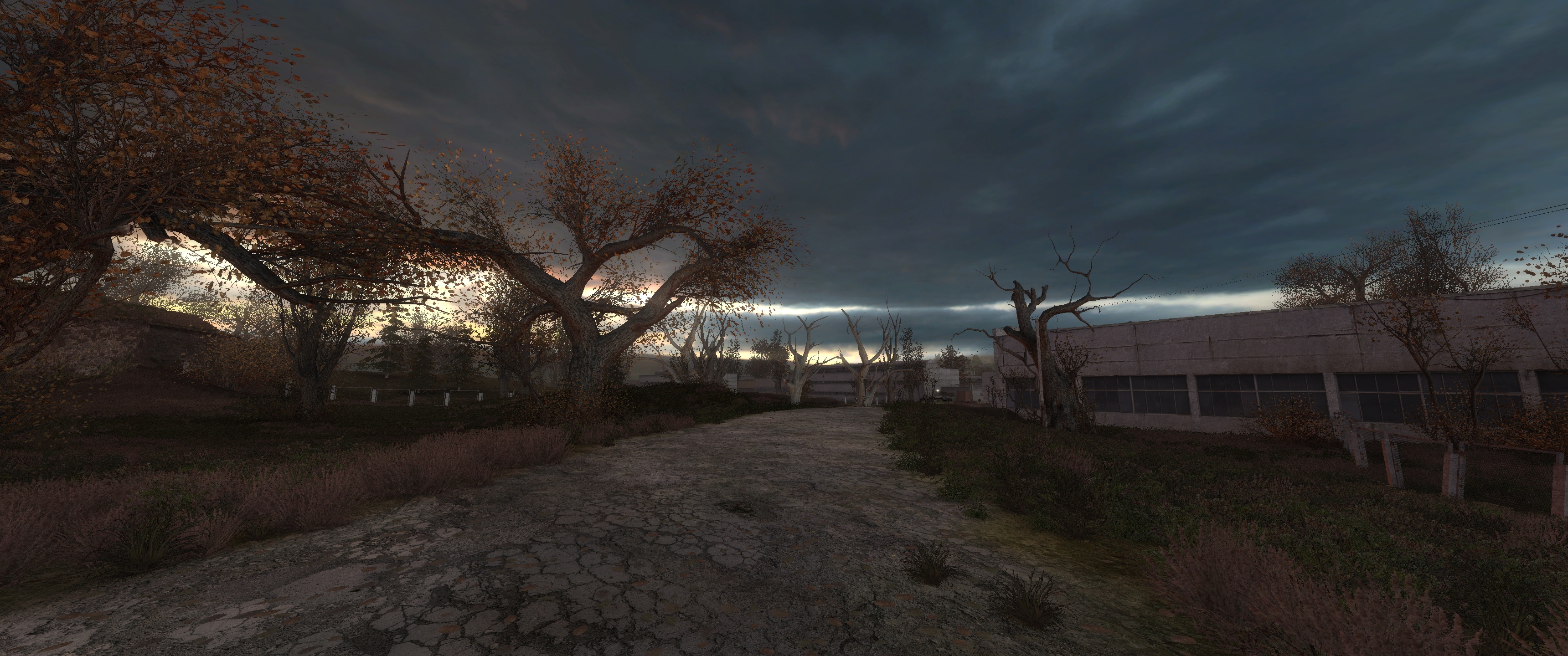
The inevitable fact of the matter is that even with a perfect translation, most gamers won’t be able to handle NLC 7, similar to how most can’t handle Pathologic 2 or even System Shock 2. Especially S.T.A.L.K.E.R. players. NLC 7 has too much content for most, requires too much thinking for most due to its complex objectives requiring intuition and thinking on your feet with no hand holding, and is too difficult for most – difficult in ways people are unfamiliar with, somewhat similar to Pathologic 2 except it makes that look like a cakewalk on its intended difficulty mode. No Dark Souls or DOOM Eternal esque difficulty here, this is much more involved. NLC 7 breaks people like few other games.
This is a hardcore survival game, and that alone isn’t a huge filter for the general gaming population (see the mainstream popularity of DayZ, Escape from Tarkov, and RUST for reference). Although there is much more to NLC 7 than those since that hardcore nature extends to its quest design.
The people playing S.T.A.L.K.E.R. today generally are not the people playing DayZ, Escape from Tarkov, RUST, State of Decay 2, or any other survival game. S.T.A.L.K.E.R., a franchise that’s well over 10 years old, has survived this long because of mods, but the mods that keep people around today (excluding the Russian community) are casual games, the complete opposite of NLC 7. Those mods are S.T.A.L.K.E.R. Call of Chernobyl and its forks like Anomaly, freeplay open world mods in which the main purpose is to just run around the open worlds and take part in faction warfare and generic templated quests that are always structured as “Go to this marked place, retrieve the item, bring it back to me” or “Go to this marked place, kill things, then come back to me” or some similar variation of this. In both of these two utmost popular mods, you obtain top tier equipment almost right away. There is no real challenge or sense of progression to be found in any of them.
In the original S.T.A.L.K.E.R. games, you’re following clearly labeled quest markers on your PDA at all times. You’re reading your journal and encyclopedia in Shadow of Chernobyl to keep up with the story (hopefully), but chances are you’re also wearing multiple endurance artifacts by the mid game, sprinting around the game world endlessly, and when the action starts you’ll be sprinting some more, jumping and landing aerial headshots, shrugging off bullets due to your powerful artifacts and quality armor, not even getting touched by mutants because you’ll just outrun them all day long. You always know where to go, what to do, and you are the God of the Zone just by mid game. This is why we at GND-Tech find it so amusing that mainstream game journalists find the original S.T.A.L.K.E.R. games to be too hard and gave them mediocre scores because of this. They are super easy games that play quite like a normal FPS in combat, and ultimately you can save scum at will.
Hardly any of that applies to NLC 7. The only one that does is reading your journal and encyclopedia, which is far more important in NLC 7 than it ever was in Shadow of Chernobyl, although both really do rely on it in order to get a full picture of the story.
But the first thing that will filter out players is probably the movement speed and the very start of the game. As the intro shows, you start off the game beat up and damaged, thus your health is low. There is a medkit for you to use immediately, but this doesn’t even get you up to 50% HP. When you’re severely wounded in NLC 7, your movement speed is severely compromised as you can see in the video above. This happens as soon as the health HUD icon becomes yellow it seems, at this point your movement speed will start to get slowed. Below that, when it’s orange and red, you will limp and become extremely slowed. Even if you heal yourself from orange or red back to yellow or even beyond, you won’t gain back full movement speed without sleeping. Many players will assume that NLC 7’s movement speed is just always this slow, so this will filter them out of the game.
Also, in NLC 7 your carrying capacity (which affects movement speed) slowly increases at least over the first few in-game weeks, the result of the protagonist slowly healing. Let this be your first glimpse of NLC 7’s insane, perhaps unparalleled attention to detail.
I do believe the general movement speed is a bit too slow in NLC 7, considering the fact that it’s an 80-100+ hour experience with lots of traveling and backtracking. Thus I’ve made an addon that edits it (part of the translation pack linked above), although even with this addon the badly wounded, slowed movement speed is still very similar to what you see above.
Yes, the movement speed along with the player starting with low HP have gotten many people to quit NLC 7 immediately. Gamers actually find it unacceptable that the player starts with low HP despite clearly being portrayed as having come out of a horrible high speed truck crash! Also, many of the younger S.T.A.L.K.E.R. fans don’t even notice the medkit or figure out how to use it (open inventory and double click it or right click use, like the original game) since the medkit looks different than in the original game.
But it’s not like you’re immediately going out and getting into combat with your low HP. No, you’re given two simple quests that sort of serve as tutorials, albeit without the usual fourth wall breaking that comes with tutorials. At this point in the game, the surrounding area doesn’t contain many mutants that will go out of their way to attack you, so you’re safe… aside for the anomalies, but we’ll get to that later.
This introductory area contains one other test of the player’s attentiveness: there is a flyer or a notice on the wall right next to where you wake up. It is written by Wolf, the leader of the notorious rookie village which is where you begin the game, giving some general tips to new stalkers which of course includes you. Every single thing on this flyer actually applies to the game, especially the note about attacking the soldiers in the Dark Valley having severe consequences…
But moving on to the second thing that will filter players, that would be the very first quest in the game, which is the iconic cut first quest from Shadow of Chernobyl where you just have to go to an anomaly field right next to the starting location, pick up an artifact, and bring it back to Sidorovich, the local trader. It’s obviously a tutorial of sorts, despite the lack of fourth wall breaking, but most players are taken by surprise when they learn that picking up an artifact will cause mild damage to the player. This creates more screen effects than actual damage, so it might unnecessarily worry you. But then you realize that NLC 7 uses an artifact container system, so this radioactive artifact that you picked up with your bare hands and put in your backpack is now causing radiation poisoning. A tutorial of sorts, like I said. Simply go directly back to Sidorovich and give him the artifact and he’ll give you something to treat the radiation. He’ll even give you food to sate your ravaging hunger, if you’re playing Build 3.0. This is excluded from Build 3.7.5 and on.
Yes, it is as straightforward as I describe it, but by this point the majority of gamers have probably been filtered out of NLC 7, even if the translation was perfect.
The third thing that will filter players is the inventory, which is explained here:
It’s actually much faster and efficient to use than the default inventory since it has inventory sorting, so you no longer have to navigate small grids holding dozens or hundreds of items like in the normal games. Not only that, but it allows you to hotkey more items.
If you’re still playing after this point, then congratulations! But more tests await you in NLC 7. The next thing that might filter out players is the realization that by default, NLC 7 doesn’t let you save anywhere any time. You can only save at campfires or lamps/candles which you can ignite. I actually recommend using the save anywhere addon, which is also part of the translation pack addon above, because NLC 7 is prone to out of memory crashes (since for some unknown reason the engine developer refuses to upgrade it to 64-bit like a 21st century application) so the last thing anyone needs is to make 1 hour of progress and then lose it due to an out of memory crash.
It’s too bad the creators refuse to make NLC 7 64-bit for some unknown, alien reason, which is its #1 flaw and it’s a fatal one. If it was stable, then the so called “campfire save system” would actually be a fantastic fit for this game/mod.
The second quest will also filter out players. It’s a very simple quest in which you must find a green container for Sidorovich and return it, but nobody knows exactly where it is, so he verbally tells you of three or so places to search for it. No quest markers. This is like The Elder Scrolls III: Morrowind and Arcanum: Of Steamworks and Magick Obscura in which you must follow basic, real world directions. But with lots of gamers living in cyberspace opposed to the real world, this might cater to skills they’ve never developed, therefore this second quest will filter out many players.
But if you can get past all of the above, then there’s a good chance you’re now in it for the long haul. If you’ve made it this far, then any point where you might get stuck later, chances are you’ll either just figure it out or briefly get some help from a guide and continue on. All the real filtering material is right at the beginning. It is these very core gameplay fundamentals – the movement speed being dependent on your well being (health and long term fatigue factor), artifacts not being safe to handle, no free saving, and limiting quest markers to only a realistic, logical degree.
Gameplay
We might as well continue to reviewing the gameplay in its entirety, since we were already discussing it above. I touched upon some of the very basic elements of survival gameplay in NLC 7, but there’s of course much more to it than that.
Getting back to the inventory, it takes the original “ammo on belt” idea from Oblivion Lost (that is, Shadow of Chernobyl before it got reduced to Shadow of Chernobyl) to the next level. A more logical level. Instead of ammo on belt, now it’s ammo in ammo pouches. You can only reload guns with ammo you put in ammo pouches. What you put in vest pouches is what you can use with hotkeys.
Yet in one very important way, this inventory is quicker/more efficient to use than the default/vanilla one: it actually has filters. In the original games, you have just one monolithic inventory screen that lists all items bunched together, with no filtering, so it can take a while to sort through all your crap to find what you’re looking for (amplified by a million in Misery mod and mods that use it). This is obviously lazy, outdated game design that you won’t find in an RPG today for example.
So the filtering is a godsend and the added inventory management mechanic is ultimately a very fitting, small gameplay layer found in many survival horror games, just handled differently here. The inventory operates in real time like most survival games.
As far as outfits go, each outfit has a specific carrying capacity which is different than the base game. So your outfit of choice partially depends on how good it is for carrying capacity. This is not a mod about hording tons of items like Misery (the mod that added Mein Kampf to S.T.A.L.K.E.R.) or Anomaly. Encumbrance greatly affects movement speed like very few games. No more hard cap of 60 kg carrying capacity, since NLC 7 emphasizes a soft cap now. If you go over the limit, which again changes based on outfit and well being, you can still move but it’s just so much more tiring and you’ll get bogged down very quickly, not unlike how Arma 3 handles it.
Another part of outfits is gas masks; many locations absolutely require a gas mask or closed cycle respiratory module to survive, due to toxic air. This is built into an outfit, it can’t be added or removed from an outfit. If an outfit has no mask, then it’s not suitable for any underground location or any place beyond Bar/Rostok.
The flashlight of NLC 7 has also been revamped as it now has a wide and narrow beam which you can select, and drains battery. Batteries are easy to acquire though.
NLC 7 doesn’t have many more status effects than in the original games (which all have more than most survival horror games), and like Shadow of Chernobyl, when you acquire a status effect a translucent icon will appear on your HUD until the effect is removed. This combined with NLC 7 having a proper minimalist HUD with nothing permament on it (i.e. you can press a key to display your ammo counter on the HUD, which fades after several seconds) is truly ideal for this sort of game. None of this nonsense in NLC 7:
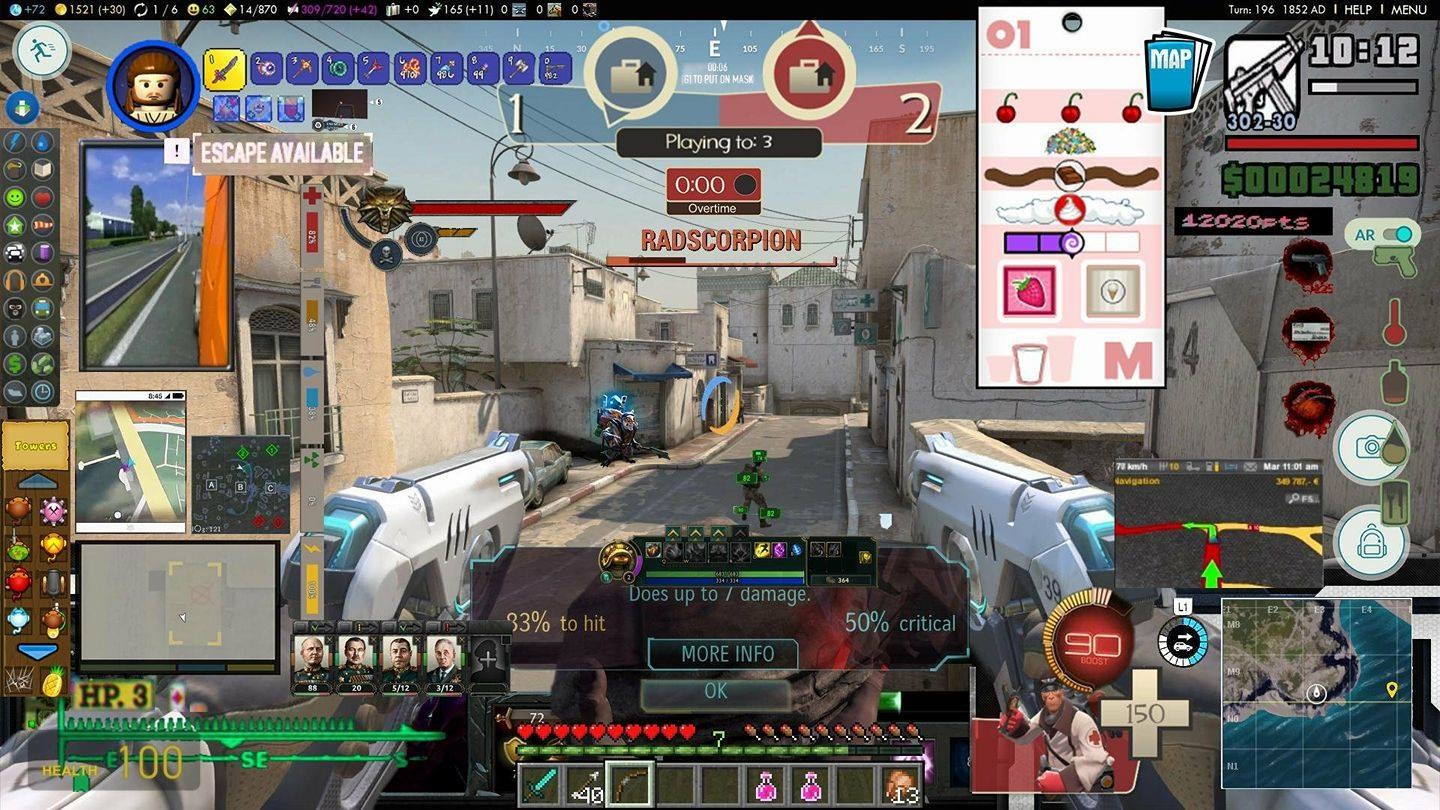
Pictured above: S.T.A.L.K.E.R. Clear Sky’s HUD
The status effects of NLC 7 are hunger, tired/sleep deprived, low HP, bleeding, irradiated, and telepathy. These all get their own temporary HUD icons.
The effects of these are quite straightforward, nothing even super hardcore here. Being sleep deprived will reduce your stamina and movement speed, as does being wounded. Hunger reduces stamina, I’m not even sure if it reduces carrying capacity since hunger should only be an issue when you encounter zombies that cause you to be hungry when near them. You’re never going to get killed by sleep deprivation or hunger, I doubt even game journalists would.
There is no thirst, even though there’s a canteen item which you can fill with water. That is for cleaning your gas mask, which you will need since it will get horribly dirty over time.
The PDA is mostly quite similar to before, except for how quest logging works. Now quest logging is a first person journal in a different PDA section, like in various RPGs (think Morrowind). Quest markers only appear when they make sense, like when a character actually knows where something is, and even then they use the bubble markers that cover a small area opposed to ones with surgical precision.
What’s different about the PDA is obtaining stashes. In the original games, you obtain stash coordinates when you loot corpses (conceptually you loot the corpse’s PDA which contains the stash coordinates). This is conceptually also present in NLC 7, except the PDA is an actual item you collect, and they’re encrypted so you must “hack” them to obtain the data inside which may or may not include stash coordinates and stories or journals. This hacking is pretty much impossible for non-Russian speakers.
Speaking of hacking, there is a cool Universal Decoder item which can be found and used to hack any electronic door in the game. There are several opportunities to obtain this at different times during the game. Unlike PDA hacking, this one is possible for someone who doesn’t understand Russian.
Weapons and Shooting Mechanics
The original S.T.A.L.K.E.R. games without mods are deeply flawed in this department. Their quantity of weapons isn’t terrible, but their omission of 7.62×39 guns is bizarre. What’s worst in GSC’s games is the balancing, especially in S.T.A.L.K.E.R. Clear Sky where the bullet sponginess is just off the charts (an unarmored bandit can survive two point blank shots from a sawn-off shotgun), where rifles without extensive upgrades are literally less accurate than airsoft guns, and all of the games have constant issues of select few guns making all other guns in the game obsolete, reducing effective diversity of your character build.
In Shadow of Chernobyl, the FN F2000 and H&K G36 just make everything else obsolete except for explosives. In Clear Sky, 12 gauge slug rounds are utterly useless and once again the F2000 and especially G36 this time make just about everything else obsolete. Call of Pripyat is just slightly more balanced here, mostly for adding the unique SIG SG-550 and some of Nimble’s special guns to the list of superior guns.
When it comes to guns in NLC 7, ammo management is one of the biggest differences versus the base game. You need to employ actual strategies for how to consistently obtain ammo, and this varies for every caliber, because of the way the economy works (more on this later). If you want to use shotguns for example, the easiest way to have a steady supply of 12 gauge birdshot ammo is by trading mutant body parts for it with the Hunter faction, but if you want buckshot or slugs then you’ll have to trade other types of ammo for those with Arnie (almost like the Metro games), or find someone who can trade you that ammo type for artifacts.
5.45×39 is the most readily available rifle ammo, with many traders being able to trade it for artifacts. You can also buy bulk 5.45 from a military trader in the Swamps in exchange for written checks. A steady supply of 7.62×39 or 9×39 or 7.62×54 will involve artifact trading with some of the biggest traders, or trading other types of ammo for it with Arnie once again. 5.56×45 and 7.62×51 are similar but involve different traders along with Arnie.
By default, 5.45×39 is invaluable for the early and mid game. You will inevitably use it here. Other options do completely surpass it once you’re able to establish a relatively stable supply of it. This is primarily due lack of stopping power, which also affects 5.56×45. You’re not going to want to use these against Bloodsuckers, Chimeras, or Pseudogiants.
Shotguns are always useful, as is the Stechkin APS machine pistol for dealing with vermin. These always have a place at any point in the game. Sniper rifles are more useful in NLC 7 than the base games too, and for end game assault rifles there’s solid justification for no less than four.
There is no classic S.T.A.L.K.E.R. Clear Sky/Call of Pripyat upgrade system in NLC 7 so weapons are balanced much more realistically, which for a game like this leads to better game balance than GSC’s approach. This, combined with the game’s general progression, means no gun is ever dead on arrival even though a few of them do become obsolete over time. And it’s much more feasible to primarily use a shotgun, sniper rifle, or a wider variety of assault rifles in this game than in GSC’s games, not only due to the statistical balancing of guns but also due to the economy and the fact that battling humans is a much smaller part of NLC 7 potentially.
As for the guns themselves? Many mods are inconsistent with the quality of their weapon models and sounds, but that is not the case here. The consistency is that of a game, not a mod. The weapon selection is richer and better balanced than in any of the official S.T.A.L.K.E.R. games, with balance being far more intelligent than any mod as well. Animation quality is that of early 2010s AAA games, making for a big step up over the base games and most mods besides GUNSLINGER. In fact, recoil is presented more realistically here than the vast majority of games.
NLC 7 also uses traditional 3D scopes instead of displaying a 2D texture over the entire screen like the original games do. Now, when you aim down a scope, it basically just changes the FOV. It’s not as nice as dual render, picture-in-picture scopes, but it also doesn’t harm performance. The thing NLC 7 does that very few other games do is let you enable/disable reticle illumination. NLC 7 also has far greater variety in optics/scopes than the original games, featuring the following:
- Kobra red dot sight which lets you actually choose between 4 reticles
- PSO-1 scope for which you can enable red LED illumination
- 1P78 scope which can also be illuminated
- The Mosin-Nagant’s 3.5x scope just for that gun
- EOTech holographic sight which has both red and green reticle
- 4x Elcan scope which can be illuminated
- High power March Tactical scope which can be illuminated
So when it comes to shooting mechanics, weapon progression and balancing, I don’t think NLC 7 really does any wrong here, and it’s by far the best in the series. Balance and progression have been taken to a completely different level, as have animations.
Economy
Since we were just talking a little bit about the economy, it’s time to elaborate. The official S.T.A.L.K.E.R. games and almost all other mods (only some other Narodnaya Solyanka based mods are exceptions) use the same boring gameplay loop of “Sell artifacts, become rich by mid game, buy all the best stuff and conquer the game entirely.” This isn’t how it works in NLC 7.
NLC 7 is all about making characters more like actual people opposed to quest-giving bots or trading bots. People want different things, people have different specialties. Russian Rubles, the currency of S.T.A.L.K.E.R., is only good for every day items in NLC 7 (as well as some bribes). When trading with people like Barkeep, Sidorovich, and other traders, you can use rubles to buy things like energy drinks, pistol ammo, other misc items which varies based on the trader.
But the main form of currency in NLC 7 is artifacts. If you want to buy ammo from Sidorovich, Barkeep, Petrenko, Skinflint and the like, you’re paying with artifacts. Same for weapon attachments, same for weapons and healing items and often times food.
There’s also an artifact dealer who exchanges artifacts for artifacts, similar to how Arnie exchanges ammo for ammo. There’s a potential military trader in the swamps who exchanges bulk ammo boxes for written checks which you have to get written out by Sidorovich or Barkeep. The ecologists use a different currency entirely. There’s a mercenary trader who buys PDAs from you using written checks. The list goes on.
All of this makes for a more believable world that is also far better balanced from a gameplay perspective. You can’t just become the richest man on earth and buy everything. You start off dirt poor, and progression is slow but perfect for an 80-100 hour playthrough. You’re never too stagnant, and every upgrade feels extremely meaningful whether it’s a new outfit, new weapon, or especially a new artifact. You will progress almost to the final moment.
Anomalies
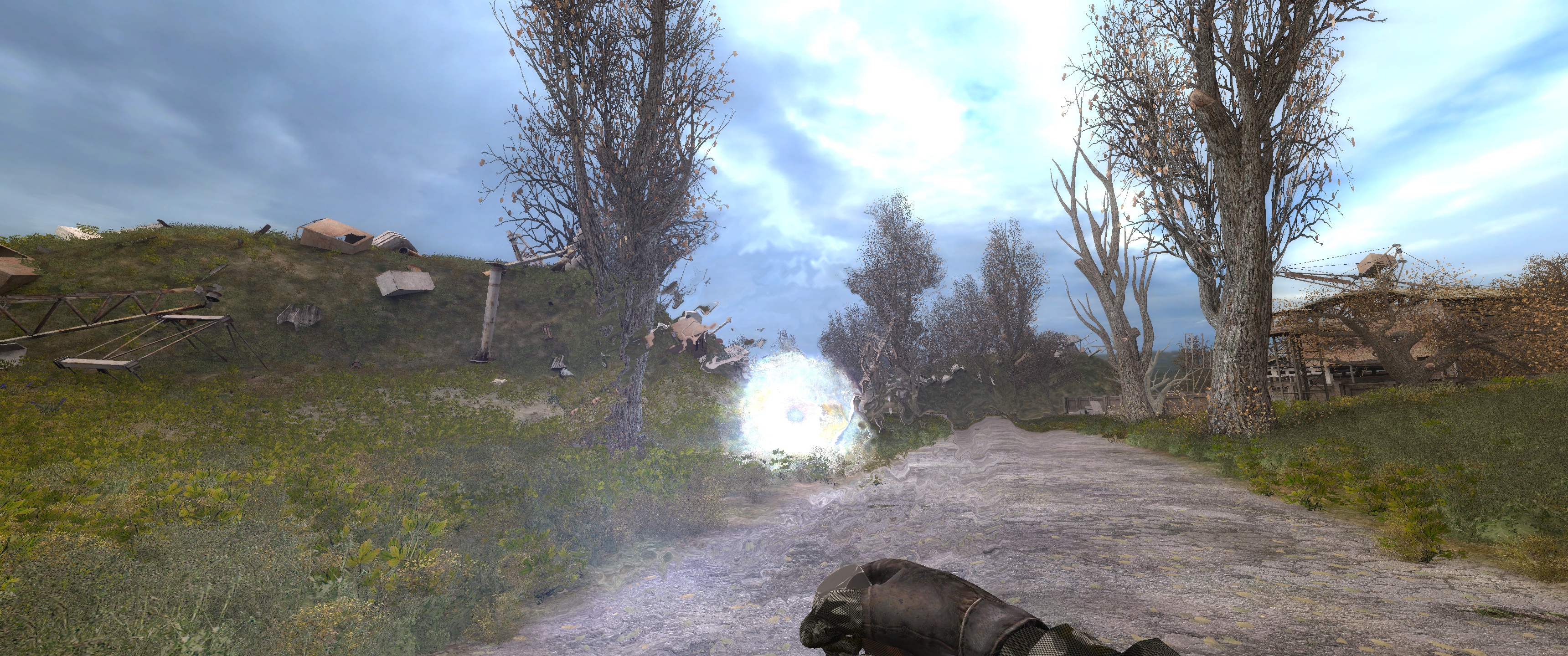
Anomalies are a scientific phenomenon in S.T.A.L.K.E.R. They are inexplicable pockets of energy that are almost always deadly. Their effects vary; the S.T.A.L.K.E.R. games feature three kinds of gravitational anomalies which damage you or instantly kill you, and then there’s the Fruit Punch which is basically an acid puddle, Electro anomalies which are just electric fields that send deadly shockwaves upon impact with anything, the Burnt Fuzz anomaly which like moss but with a different texture and appearance that burns faster moving objects upon impact, Burner anomalies which is just a burst of fire that activates upon impact, and some variations of these like moving Burners and such.
Clear Sky introduces space anomalies as a plot point, but not a gameplay point. People get trapped in space loops essentially, and need a Compass artifact to escape. In all three games, anomalies are very easy to detect; they’re all loud and have very obvious visual indicators. Almost every anomaly can be detonated by a bolt or creature which also triggers a small window where you can safely move through them (even when it doesn’t make sense, like with the Burner and Fruit Punch).
Call of Pripyat really dumbs things down by cordoning off all anomalies into dedicated “anomalous zones” on maps, so you can sprint around even more freely without a care in the world.
But in NLC 7, anomalies are a game changer. They will kill you more than anything else in the game.
All of them have less visual indication, making them harder to detect. The biggest “gotchas” are Whirligigs, which only have a visual indication high above the ground (swirling leaves), and most of all the so called Jelly anomaly which takes after the Witch’s Jelly from Roadside Picnic.
But NLC 7 also features dynamic emissions like in Clear Sky and Call of Pripyat, and like the lore says they move anomalies. The official games don’t have the guts to do this as it was deemed too hardcore. There are virtually no permanent safe paths in NLC 7, and sprinting is very dangerous due to anomalies now. There are so many more anomalies in NLC 7 than in any mod I’ve played, let alone the easy peasy official games. Here’s a breakdown of NLC 7’s new anomalies. Note the names might not be translated correctly:
- Jelly: Mentioned above, this anomaly is invisible until an object or creature makes physical contact with it, during which it glows purple and causes acidic burns which is a bad damage type as it can badly damage outfits.
- Swallow: This one is audible from a distance and not at all subtle visually. It looks like black mud being splashed around and sounds disgusting. Getting close to it causes it to swallow you whole and you will die within seconds. It isn’t that effective against mutants since they can usually get out of it, and NPCs avoid it.
- Snow: It looks like a small pocket of snow, and sounds like an alien snow storm. The fact that NLC 7 anomalies are harder to accurately describe is a very good thing. Making physical contact with it deals some damage but usually nothing too serious unless you stay there.
- Matrix: Looks like a green hologram displaying alien patterns and sounds like you’re getting absorbed into a computer simulation, hence the name. Being inside one for just a few seconds will instantly obliterate you, but before that happens you’ll see some weird visual effects. This anomaly is rare.
- Space Anomalies: They usually look like large, clear bubbles like the ones in Clear Sky’s Limansk location. They usually teleport you to a preset destination, but some can be “activated” by wearing a particular artifact on your powered belt, thus taking you somewhere else.
- Teleport: The same teleport anomalies you see at the power plant in both Shadow of Chernobyl and Clear Sky, except they can spontaneously appear on many maps and their destination seems random. Some must teleport you into a solid object or something since in these you die instantly and get gibbed.
The best thing about NLC 7 anomalies is that they’re less consistent and more weird. You can find out how to “activate” some spatial anomalies on your own, there are more unique one-off anomalies, you can “dispel” certain anomalies, you’re just less certain what they are and what they do. The fact that GSC’s games never accomplish this is a failure on their behalf.
Artifacts
Like just about every other mechanic, this one has been changed significantly. Artifacts are the mysterious creations of anomalies, embodying some of their properties, empowering the user (with some side effects). They’re the main reason for stalkers flocking to the Zone due to their powers and value most of all.
In Shadow of Chernobyl, artifacts are just scattered around the game world waiting for you to approach and pick them up. That’s it. The vast majority are very weak individually. You just thoughtlessly horde artifacts in your backpack, there’s zero gameplay involved with acquiring artifacts really. The gameplay comes from wearing them, by weighing their benefits and harmful side effects. You can wear up to five artifacts in Shadow of Chernobyl.
In Clear Sky, artifacts are individually much more valuable and powerful, both in their benefits and harmful side effects. Also, the amount of artifacts you can carry is based entirely on your outfit which can be upgraded, but the maximum is still 5 which only a few outfits can support. Artifacts in Clear Sky are invisible and magically appear out of thin air if you equip a detector capable of detecting them while next to the artifact. It makes no sense, but at least you have to go through hellish anomaly fields to obtain artifacts now. Due to their significantly increased value, you get rich quick by selling artifacts in Clear Sky. You only have to sell a handful to conquer the game’s economy, which is funny since artifacts respawn in all of the games. Call of Pripyat mostly takes Clear Sky’s approach to artifacts.
NLC 7 artifacts are not invisible, they don’t only spawn in anomaly fields so they will usually spawn in seemingly random places like in Shadow of Chernobyl, but in far smaller quantity. They’re more rare and more special. Artifacts in the official games only counter anomalies (e.g. resistance to fire damage) or provide resistance to physical damage or increase carrying capacity in Clear Sky/Call of Pripyat, but in NLC 7 there are many with other properties. Some can increase jump height, some repel certain mutants, and more.
Shadow of Chernobyl only has four artifact “tiers” while Clear Sky and Call of Pripyat have three. Since NLC 7 is many times longer than those games, it has more:

Not only are there more artifact tiers and far more variety in the effect of artifacts, there’s also artifact transmutation, mostly inherited from AMK mod but it has its own version too. Essentially, you can combine certain mutant body parts (which you can of course collect from mutants) with an artifact into an anomaly to create another artifact, although the effect is never instantaneous. Other “recipes” involve simply throwing an artifact into a certain anomaly and giving it time to transform.
Artifact transmutation plays a big part in NLC 7’s gameplay loop, because artifacts play a much bigger part than in any of the original games and any other mod that isn’t based on Narodnaya Solyanka. You will even need certain artifacts to get past certain quests, and you’ll usually have to source them yourself.
Artifacts are far too tame and repetitive in the original games, and also extremely boring in many mods such as Lost Alpha Developer’s Cut, but in NLC 7 there is so much utility to them, since they’re used for trading and recipes, so that even the most worthless ones (the “Degenerates”) are valuable. Artifact gameplay in NLC 7 becomes addicting. Most players will become fixated on obtaining the best ones once they learn of them, I know I did.
Note that you can’t perform any transmutations you don’t have the recipes for, to prevent exploitation. Recipes are acquired from other stalkers by completing quests, or from looting corpses.
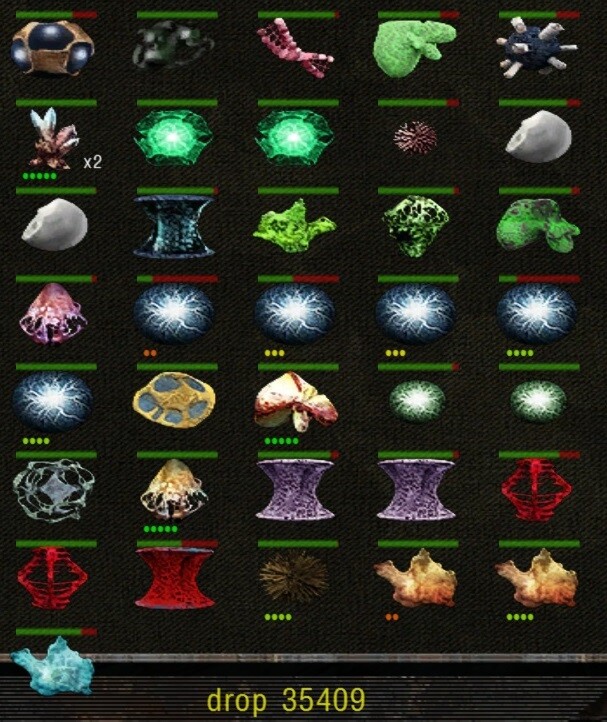
We also mentioned that radioactive artifacts need to be placed in containers strong enough to protect you from their radiation. There are three containers in NLC 7; one with many artifact slots but lower overall radiation protection, one with 3 slots and very good radiation protection, and one with a single slot that can safely hold any artifact.
One of the biggest changes to artifact gameplay is the belt system. Thankfully the belt is now separate from outfits, which is logical and better design. By default, your belt can’t hold any artifacts, but it can be upgraded with artifact slots, to a maximum of five. You can also find them in the game world.
But simply placing artifacts on your belt does nothing. After all, why would they work on your belt but not in your backpack? Body heat? I don’t buy that excuse. NLC 7 inserts logic into this gap that was previously void in GSC’s games once again. The artifact belt in NLC 7 is connected to a battery, a separate item that drains. So to use artifacts, you place them on your belt and you need a charged battery in the dedicated inventory slot to power the belt, sending an electric charge through the artifacts, thus activating them.
This more logical design has gameplay benefits by making artifact usage tied to batteries. It’s more survival gameplay, it means you have to be more thoughtful about how you use them, especially in the one map where time moves much more quickly, greatly accelerating battery drain. Artifacts also degrade over time when used/powered, though even when unused they will slowly degrade in the form of their tier being lowered. For example, a “5 star” artifact will eventually become a 4 star even when not being used, and can continue to creep down.
But when actively using/powering artifacts, they degrade over time until they become inert. This takes a long time though, so it’s not annoying but does encourage thoughtful artifact usage. And there is a way to “recharge” artifacts later in the game, using the strange, deadly anomaly field in Clear Sky’s Red Forest location.
Mutants
NLC 7 alters mutants to give them new abilities that blend nicely into the game. They don’t look, sound, or otherwise appear tacked on like so many other mod addons. These new abilities make mutants far more dangerous than in any other S.T.A.L.K.E.R. game or mod. Mods like Misery 2 think that just making mutants very bullet spongey or making Controllers drain your HP almost instantly within a radius around them is intelligent difficulty design, but that’s obviously not the case. NLC 7 however thought outside the box when redesigning mutants, and the results are a success.
Here are the new mutant properties in NLC 7:
- Blind Dogs now have a mild telepathic effect. Individually the most it can do is cause you to drop whatever weapon you have equipped (if any) if you stay around one for too long, and I believe this is limited to the “strong” dog (near-white in color). But Blind Dog packs will cause visual disorientation and increased chances of dropping your weapon.
- Pseudodogs now have a mild telepathic effect; if they detect you and see you aiming a gun at them (aiming down the sights or scope), they can cause severe visual disorientation for as long as you’re aiming at them. No effect if not aiming down sights/scope, and no effect if they don’t see you.
- The skin of Tushkano now causes mild bleeding just upon physical contact with the creature.
- Cats have a mild telepathic effect, making you sleepy if in close proximity to one. Individually this effect is very weak, but a group of cats will cause you to yawn and blink your eyes a lot.
- Boars emit a mild radioactive field that also slows movement when in it, the same exact effect that Pseudogiants have in Call of Pripyat.
- Zombies have a telepathic effect that causes you to go hungry when close to one. This effect is pretty strong thus dangerous, as you can enter a starving state by being near them for too long.
- There are now exploding Zombies which explode into a large puddle of nasty looking pus or goo that causes immense damage.
- Bloodsuckers have a new secondary attack – some kind of ominous low frequency sound and energy pulse that emanates from their body, it causes you to stop sprinting (but you can immediately start again) and deals significant damage. This also prevents you from sitting on top of a rock while surrounded by Bloodsuckers since they’ll just kill you with this. A special artifact reduces the effects of this new attack.
- Chimeras, which have the old cut Oblivion Lost sound effects which are far more animalistic than the obviously computer generated sounds in Call of Pripyat, emit a screetch that prevents sprinting for a few seconds and makes you tired. This makes close range encounters with them almost guaranteed death.
- Poltergeists and Pyrogeists are now immune to all forms of damage except for fire and explosions.
Aside from these, it has the usual mutants with the usual abilities, including Burers which now have an eerie sound to them, and also Fractures. There are no other cut creatures in NLC 7 besides rats. No plague rats, no plague zombies. This mutant rebalancing and their new attacks effectively counter past exploitation techniques available in GSC’s games. Brilliant design! These changes make mutants properly threatening unlike the rest of the franchise and most other mods.
And for those who don’t know S.T.A.L.K.E.R., as you can see the mutant diversity is pretty good. A game this lengthy could do with more, but it’s satisfactory overall with how progression is designed in NLC 7. Mutants are not excessively bullet spongey except for Boars and maybe Cats, and the ones that should be like Pseudogiants and Chimeras. Bloodsuckers and Snorks can be reasonably put down with headshots from any rifle, unlike in Misery. The mutant design goals of NLC 7 isn’t to make them invincible (except for Poltergeists/Pyrogeists), you can kill them but they can kill you VERY easily. This is how it should be.
My only mutant related complaints are that Boars and Cats shouldn’t be quite as spongey (easily fixed by an addon I’ve made, part of the aforementioned translation pack download), and Controllers are too vanilla. They pose no threat at medium to long range which is where you’ll often see them, so you can just safely pick them off. OGSE 0693/OGSR did better work revamping Controllers, although I don’t think anyone has solved the problem with them being exploitable at distance. This needs better AI or they should stick to close quarters exclusively.
Also, the flamethrower’s range is annoyingly, unrealistically short, so using it against Poltergeists in Lab X-18 is a nightmare.
Level Design
NLC 7 is not like anything else in S.T.A.L.K.E.R. when it comes to level design. The Zone is obviously meant to be a mysterious, inconsistent place that defies logic. Every step you take is supposed to worry you. This is how it’s portrayed in Roadside Picnic and Tarkovsky’s Stalker movie, but all three official S.T.A.L.K.E.R. games totally fail to deliver here, as do almost all other mods.
But NLC 7 goes as far as possible on X-Ray engine to achieve this. We already mentioned how much more unpredictable anomalies are, as they’re always moving and there are more unique ones. We also mentioned how every underground location as well as every map beyond Bar/Rostok needs a gas mask to survive, but we did not yet mention the unique inhospitable levels.

There are four maps that are always inhospitable, not counting the maps covered by the Brain Scorcher while that’s active. Those maps are:
- Misty Thicket: This forested area is perpetually covered by dense fog and you will periodically, randomly get spun around here. Time moves exponentially more quickly here. This really makes things more challenging from a survival gameplay perspective since now batteries drain several times more rapidly. As a result, you will never want to use artifacts here, or any other battery powered equipment. Your stamina, hunger, and bleeding rate are also sped up exponentially (but so is healing), so a small wound can kill you. Your gas mask gets filthy at the same accelerated rate so you’ll have to clean it constantly. In addition, this location simulates mutants stalking you, usually Pseudodogs but not always. Though it’s rather cheap in that you’ll hear fake ambient sounds of them stalking you and then they’ll spawn near you, although this is rare.
- Tesla Zone: This is the old cut “Generators” map, but it isn’t Generators anymore. It does have the iconic massive, strange generators which create a deadly electric field covering nearly the entire area, so if you go here unprepared you’re just going to get shocked to death. Eventually you can pay someone to map out a safe path for you, and elite outfits and artifacts will partially protect you from the electric shocks.
- Ivankov District: Ths is the old cut “Dead City” map, a fan favorite. The map outside the city is hospitable, but the city itself is not. Your stamina drains more rapidly the closer you get to the center, where the Lenin statue is. You cannot spend much time in the city.
- Pripyat: Seems to exhibit similar effects to Ivankov District the closer you get to the stadium/path to CNPP, but not as severe.
NLC 7 maximizes the level design of existing S.T.A.L.K.E.R. maps by filling them out with more interesting content such as anomalies, stashes, NPCs, unmarked quest content. It has more maps than any of the original games, having all of Shadow of Chernobyl’s and Clear Sky’s with some modifications, along with the maps specified just above, Darkscape, an underground Labyrinth map, a multiplayer village map repurposed into a single player map, and more labs than most mods.
The lab design of NLC 7 are the best I’ve seen in S.T.A.L.K.E.R. Labs are supposed to be the scariest parts of S.T.A.L.K.E.R. gameplay, but they were always rather mundane before and most mods don’t improve upon things here. NLC 7, which benefits from having additional labs, is much more creative with its lab design, even having more ways in and out of them. They are creepier, more challenging, more unsettling, more detailed, and you don’t know what to expect in them. They’re not perfect, but for X-Ray engine this is about as good as it’s going to get.
My main wish for NLC 7 with regards to level design is replacing its Yantar map, which is the original one from Shadow of Chernobyl, with the cut one from Oblivion Lost, also seen in Oblivion Lost Remake and Lost Alpha. The area is called Lake Yantar, but nothing amounts to a lake in the area you see in the game as there’s only room for a small pond. Not only is it really a lake in the old map, there are more points of interest (at least eight compared to just two in Shadow of Chernobyl), and the underground section is more unique due to multiple entrances, a large freight area, a metro tunnel, and it could lead to some seriously intense cat and mouse gameplay if used well.
But again, NLC 7 does make the best use with what it has. Every area is far more rich and interesting than in the base games and any other mod.
AI and A-Life
A-Life is a major focus of Call of Chernobyl based freeplay mods, since those are about faction warfare and nothing else. NLC 7 has an extremely tightly crafted story so A-Life is not let loose here. Important characters cannot go wherever, whenever, the plot depends on some of them being accessible so their movements are scripted. Important characters can die too, and NLC 7 compensates for this like a proper RPG does too – either with quest failure and various consequences or by replacing the dead character with a new, unique character along with various consequences. What NLC 7 avoids is having important NPCs get lost. This limited A-Life isn’t harmful to gameplay, it’s the opposite for ensuring that quests don’t break.
NLC 7 is more realistic than all these warfare mods, and is more inspired by Roadside Picnic and Tarkovsky’s movie, so The Zone is never a warzone here. People don’t want to draw too much attention from the government. With that said, NLC 7 does enable some new AI behaviors like moving corpses out of the way and healing each other, so the important bits are here.
Mutant A-Life seems effectively the same as the original games. They’ll feed, they’ll sleep, but per-map mutant spawns are specific which does some make sense; some mutants will prefer different environments or terrain after all. But I do wish mutant encounters were more dynamic and random.
These are the extent of AI changes over the original games. For those unfamiliar with S.T.A.L.K.E.R., it uses a GOAP AI system that has proven to be one of the most advanced as far as shooters go, especially the dynamic A-Life element even when restricted. It of course has its faults and glitches, but they’re relatively uncommon and are usually hilarious.
Writing and Quest Design
So NLC 7 has the most elaborate, thoughtful, balanced, and complex gameplay in the S.T.A.L.K.E.R. series, which to hardcore FPS and survival game fans means it has the best gameplay in the franchise. But now let’s get into this mod’s two main strengths.
NLC 7 is effectively a reboot. It takes some core elements from Shadow of Chernobyl’s plot, but tells a new story. Shadow of Chernobyl is a mysterious game that conceals an anti-Soviet story underneath, although it never properly explores any characters. NLC 7 is a much more layered story that examines individuality, the unforeseen and far-reaching consequences one’s actions can have, and rich existential horror.
You play as Marked One, survivor of a Death Truck crash, shown in the same intro cinematic as Shadow of Chernobyl. You awake with amnesia and just a PDA saying “Kill Strelok.” Sidorovich indirectly saves you and put you to work as his errand boy for this reason. Like in Shadow of Chernobyl, he puts you to work to help him try and uncover a path to the center of The Zone which is no man’s land, it’s the new Klondike, and along the way he says he’ll help you uncover who you are.
There’s also talk of a monolithic stone in the center that grants wishes (similar to Tarkovsky’s Stalker), referred to as both the Wish Granter and Monolith. So there’s effortless motivation to push forward. And like in Shadow of Chernobyl, this all leads to labs X-18, X-16, the Brain Scorcher, and eventually the power plant itself.
But things are not as similar as they sound. Every quest is changed, the structure of quests is totally different. The contents of those labs are very different and there are other labs too. There’s virtually no hand holding as mentioned earlier, just a first person journal in your PDA for quest tracking.
NLC 7 illustrates these quest design differences early on, with the quest to rescue Nimble (or rather the flash drive he’s carrying) from bandit captivity nearby. In Shadow of Chernobyl, you simply go there and kill all the Bandits and collect either Nimble or the flash drive off of his corpse. You can still do it this way, but it’s not the only way.
This task seems suicidal, so you can decide to scope out the area and then return to Wolf to voice your concerns about being badly outmanned and outgunned. The game doesn’t tell you that this is an option; NLC 7 demands real world intuition and thinking. Wolf will then suggest you approach the camp totally unarmed, and if you do this they won’t shoot on sight. After some conversation, they will offer to trade Nimble for a PDA located in an area called Darkscape. Off you go, except to get to Darkscape you have to meet a new faction – the Hunters. They’ll let you pass if you can provide them a mutant body part, to show that you’re doing your part in thinning the mutant population.
You can find this PDA in Darkscape and return it to the bandits, and indeed they let you and Nimble go. This sounds like unremarkable quest design, until you learn of the long term consequences of this one quest, which we list below:
- When you first enter the Garbage, a few bandits are robbing Yurik like in Shadow of Chernobyl. Normally they will offer to let him go in exchange for two artifacts, but if you peacefully rescued Nimble, this requirement drops to one artifact because they’ve heard about you.
- Not only this, but if you get them the artifact, they tell you about a secret entrance to the Dark Valley level, which bypasses a military outpost. This is great since killing the military in Dark Valley (or at least their commander) results in Major Kuznetsov, the Cordon bridge outpost commander, refusing to work with you, and he can become a very valuable ally throughout the game.
- Much, much later in the game, you come across a bandit gang in the Red Forest. If you’ve peacefully rescued Nimble and helped the guys in the Garbage, they will know of you by now and offer you a quest with a very rich reward. If you didn’t do any of this, they are hostile on sight, and killing people has consequences.
And this is merely the third quest in NLC 7. Quest design branches out more and gets even more complex. The lack of hand holding, the need for intuition, the open endedness of the quest design, the fact that the world and its inhabitants don’t wait on you forever, this is all utterly unlike S.T.A.L.K.E.R. and more reminiscent of Pathologic or even some of the best classic RPGs like Fallout and Fallout 2. To illustrate this point, here are a few other examples.
Spoiler Warning!
- The quest to help Bes defend against the Bandit attack in the Garbage, which exists in Shadow of Chernobyl. Here, Bes knows the attack will commence at around 19:00 and you must ask other NPCs for help before then. At 19:00, whether you’re ready or not, the attack commences. NLC 7 does not wait on you.
- A mythical artifact called the “Black Mark” may appear in your inventory, and the chances of this occurring raises with each person you kill (but after a certain plot point it will almost certainly appear at some point). It’s an omen; it causes serious debuffs (e.g. max HP reduced to around 45%, increased hunger, occasional visual distortion, and more), and you cannot discard it as the only way to part with it is to have another stalker willingly take it from you. It is known that anyone who carries the Black Mark doesn’t live for long. This is a totally unmarked quest, like so many in NLC 7, so I used my intuition and asked every important, knowledgeable character about it, e.g. Sidorovich, Barkeep, Vitek Voron aka Raven, Sakharov, and each had a different piece of advice. I decided I wanted to selfishlessly get rid of it ASAP, so tried to trick some rookie stalker into taking it from me, since the dialogue options were there for it. None fell for it, as the Black Mark is a widely known legend, so I ended up paying a rookie a lot of money to take it from me, and that was the end of that… for a while at least. I knew this decision was the wrong thing to do and might come back to bite me, but I did it anyway. This Black Mark also has connections to the Monolith/Wish Granter, revealed much later in the game.
- Various quests where someone will say something like “Meet me in this location at this specific time” and if you miss the meeting, you miss the quest, like in Pathologic. I remember one quest where I found an interesting PDA on the corpse of a scientist, so I took it to the scientist who might know something about it. I convinced him to look into it for me, but he was extremely busy so he told me not to bother him. If you talk to him before he has a chance to clear up his plate and look into it, he gets pissed off and throws the PDA back at you and will never look into it.
- To enter Lab X-18, you need two electronic keys like in Shadow of Chernobyl. Barkeep gives you one, but the other is owned by Borov, again like in the original game. In the original game you merely kill Borov, loot him, kill the X-18 guards, invade X-18, kill everything inside without issue, and collect one document and then you’re done. But this time you can get the key from Borov without killing him. Barkeep suggests talking to Snitch, since he has contacts in Borov’s gang. Indeed, Snitch agrees to help arrange a meeting between you and Borov but only if you help him first, and Snitch’s quest is fun and surprisingly challenging (but rewarding). Once you help him out, you can just enter the Bandit base and talk to Borov. He’ll make you do some quests (which are again not tedious or meaningless) and then he will give you his key. But there’s one other problem: the entrance to X-18 is blocked by lots of rubble. It’ll have to be cleared and by explosives or a team of construction workers basically. You can ask Barkeep, Borov, Vitek Voron, or one other NPC to clear the rubble for you. Each asks for a LOT before they do this, although what Borov asks for is just a bunch of food/drink for his guys who will remove it for you – a pain in the ass to carry all the food to him, but cheap and easy and the only solution that doesn’t involve killing Borov’s guys who guard the entrance. Once you clear the entrance, there’s ANOTHER issue: you pretty much NEED a flamethrower or lots of explosives because these are the only ways to kill the Poltergeists in there, and surviving without killing them is unfeasible at this point in the game. There are 2 or 3 ways to get a flamethrower which is the best/easiest solution for this quest. Once you get this taken care of, you can finally enter, only for X-18 to be without power (you can turn on power near the entrance but it doesn’t work throughout most of the lab), you need to wear a gas mask to survive it, and you have to collect multiple documents and there are more electronic code locked doors inside, among other changes.
- To enter Lab X-16, you need to find a way to get past a powerful anomaly that’s blocking the entrance. If you do your detective work, you’ll learn about a rumor that states that wearing all three Emerald artifacts can allow you to bypass the anomaly. Then you’ll have to follow up on these leads and figure out how to obtain them. You may or may not have one already, you can learn about a location where one was seen recently, and you can possibly obtain a transmutation recipe for crafting one of these Emerald artifacts, and as usual for NLC 7 and the greatest classic RPGs, you don’t pick up this information by following objective markers blindly. No hand holding, ask more knowledgeable characters, do favors for people, make friends, read looted diaries.
- But that is not the only way into X-16. A player with very keen detective skills can learn about an alternate entrance to X-16, located in a mysterious and dangerous place. Figuring out how to get there is a challenge, actually getting there is another challenge, and once you’ve done this you find out that this entrance is also blocked by a different anomaly. You can figure out that a specific Ruby artifact is needed to dispel it, and then you have to figure out how to obtain one in the usual nonlinear, no hand holding fashion. Perhaps you have it already? Or perhaps you have the recipe already at this point?
- After the Brain Scorcher is disabled, many stalkers, including some key NPCs, move north and take up residence in different areas. Other things like this keep it feeling dynamic.
I think you get the idea. NLC 7’s quest design branches out more than most RPGs with more lasting consequences than most. This combined with its lack of hand holding makes it a thoroughly immersive experience, demanding real world intuition and logical thinking to figure out how to progress. Quest design is nonlinear, creates tension, and leads to awesome gameplay/encounters. For the “immersive sim” crowd, NLC 7’s quest design and world design should provide greater immersion than any other.
It does sometimes use the usual technique of a quest sending you to a new area which may have a unique anomaly or a particularly challenging mutant encounter, but it doesn’t overuse this like a Bethesda game and these new locations you discover aren’t as shallow as a basic dungeon crawl leading to a treasure chest. Side quests can lead to interesting story revelations, or ways to make the game easier for yourself like obtaining the universal decoder earlier, or finding alternate paths between maps, and much more.
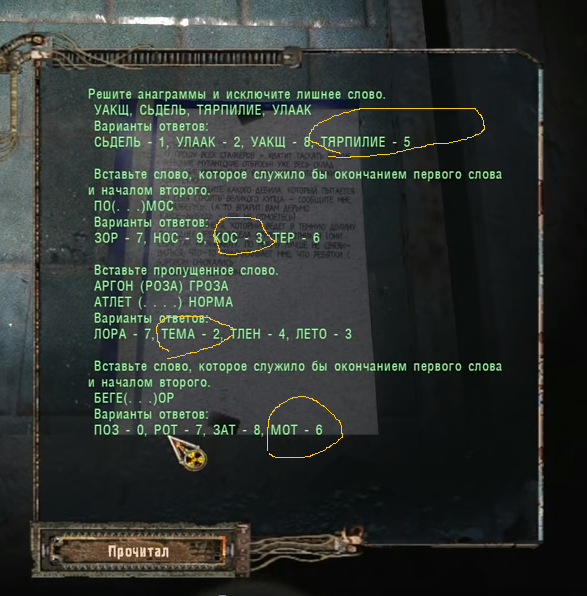
Locked doors are sometimes more complex to deal with in NLC 7.
Even its cyclic side quests, which are generic quests present in all the original games, are more interesting here, mostly due to the rewards. The rewards for all quests are very carefully selected and balanced, putting character progression on the forefront of NLC 7 game design. As a result, NLC 7 quest design is most satisfying for those who are story-first gamers, and also most satisfying for those who are gameplay-first gamers. But it is absolutely not fitting for casual gamers, which is why NLC 7 will never be popular among Western S.T.A.L.K.E.R. fans.
So the plot is obviously greatly extended compared to Shadow of Chernobyl, and side quests make up a far bigger portion of the game making Shadow of Chernobyl seem comparatively empty; for example, by the time you finish X-18 (or at least your first visit) in NLC 7, that same amount of play time is enough to finish Shadow of Chernobyl, and this is not even 1/3 of NLC 7. But the changes don’t stop here, NLC 7 has a completely different story than Shadow of Chernobyl entirely which we’ll go over below.
You will also notice that quests almost always have non-violent solutions. It’s even encouraged, from the existence of the Black Mark artifact to the greater rewards you’re presented with for handling things peacefully. The only mandatory violent human combat encounters in NLC 7 to my knowledge are the soldiers in Agroprom Underground, 2-3 random bandit gangs, if you want to help Bes then you’ll need to kill bandits, one mercenary encounter near the very end of the game, and I think that’s all of them.
NLC 7 encourages you to think before you act, to remember that every other character in the game is also human, and it does this without shoving blatant morality mechanics down your throat like a BioWare game. It does this naturally, by presenting a world that works less like a typical game and more like reality. A world with choices and possibilities not spoonfed to you, and just a simple note in one conversation strikes a chord: “Remember, they’re human too.”
Another noteworthy change in writing focus is character development; to go along with the emphasis on non-violence, NLC 7 makes sure to portray people as people. There’s a real lack of villains in NLC 7, and that is deliberate. No bad guy Western mercenaries, no bad guy Ukrainian military, no bad guy Soviet scientists. NLC 7 has a lot more dialogue focus than most games, characters that are flawed and will discuss how they feel and sound human in the process. I’m pretty sure it was heavily influenced by Roadside Picnic and Tarkovsky’s Stalker movie.
But this is just barely scratching the surface. The plot deviates completely after disabling the Brain Scorcher. Getting into this will require a spoiler warning.
Spoiler Warning!
In Shadow of Chernobyl, once you disable the Brain Scorcher, the man made radar system that creates a psi field to protect the center of The Zone by melting peoples’ brains (with a gaping plot hole here due to the Monolith faction being able to magically travel through it and back without getting their brains melted), the game becomes a linear sequence of high intensity combat until the very end of the game which is only an additional 90 minutes. It is cool and it is fun, but NLC 7 is so much more.
When you disable the Scorcher in NLC 7 (you actually just open the way for someone else to do it, since NLC 7 doesn’t revolve entirely around you), you’re not too far beyond 50% finished with the game. The plot deviates completely here. After you disable it, everything, or more specifically everyone in the vicinity, becomes strange. Everyone wanted this moment to happen; no Scorcher means you can rush to the center of The Zone and acquire an untouched treasure trove of artifacts. The new Klondike! But that’s not what happens. Everyone loses their will completely. They lose all motivation, their will to push on, they become apathetic and just sit around talking about how hopeless everything is. Spellbound.
At this point in the story, you begin to question your actions. You didn’t have a full understanding of what the Brain Scorcher is. What have you done? That was a drastic action with no understanding of the consequences. All you did was create another problem. Other characters agree, so you actually set out to turn it back on, once you learn of another frequency it can operate at where it shouldn’t melt peoples’ brains and should counteract this field of apathy (obtaining this information is a crazy journey in its own right).
Disabling the Brain Scorcher just leads to new mysteries. It makes you realize that your assumptions this entire time were dangerous, and NLC 7 continues to hit you with curve balls beyond this, and the tempo is perfect. The new focus of the plot here is Strelok’s group, which isn’t just Strelok, Fang, Ghost, and Doctor in NLC 7. He worked with a team of unknown scientists and their research into The Zone shed more light in some areas than what any other group is known to have uncovered.
So you pursue this group, their headquarters, and it leads to some very unsettling revelations as the story shifts to far more existential themes. They were studying the nature of The Zone and the fabled Wish Granter, and what they found is something out of a Lovecraft tale.
In Shadow of Chernobyl, The Zone was the result of a group of Soviet scientists who joined together seven minds to create a super-consciousness. They say their goal was to alter the noosphere to remove negative human behaviors from the planet, but this is the Soviet Union attempting global mind control so make of that what you will. And the Wish Granter (aka the Monolith) was just an illusion they created for indoctrination. And there are tons of unanswered questions surrounding all of this.
But in NLC 7, Strelok’s group discovers that the Monolith is an alien entity from another world that only partially exists in ours, so we can’t just go and destroy it (and who knows what would happen if we try). It is a parasite, a virus that seeks to spread, and it spreads through our minds. Strelok’s group determines it is responsible for a significant rise in mental illness over the last century (a statistic that actually exists). It is a Lovecraftian existential horror entity that is relevant to today’s world, as the world today is in a mental health crisis.
One important thing you learn here is that this Monolith, this alien, wants to spread its influence is through artifacts (and other means). It uses them as bait for humanity to come to it. The more people in The Zone, the more it can spread its influence. Once you learn this, you’ll want to throw away all of your artifacts. Just like when you disabled the Scorcher and realized it was a mistake. Brilliant. This kind of writing is why this game ranks not only on our list of greatest video game stories, but also on our list of masterpiece games about a virus outbreak.
The existential terror here is powerful. This monolithic crystal is some kind of cosmic entity that invaded our world nearly undetected. It seems to have the power of a deity. It does not merely destroy like some simple beast, it gradually but perhaps methodically influences human conscience on a planetary scale, and in negative ways. After the Brain Scorcher is disabled, we see that this entity has the ability to wipe all emotion from people. What if it did this across our entire planet? Or what if this rise in mental illness continues to get worse, how far will that go? Will it stop with humans? How do you stop it?
Then there’s the Black Mark artifact. Multiple theories are presented in-game about it; some say it helps spread the Monolith’s influence, but Strelok sees it as some sort of important key that might help resist its influence. But the fact that you receive it when killing people can lead to its own theories. Very late in the game, you can do a main quest that results in a team of Mercenaries giving you a strange tool that looks like a container of some kind, that can supposedly allow you to pick up a Gauss Rifle (normally it drops out of your hands, and if someone without a S.T.A.L.K.E.R. tattoo picks it up, they disintegrate), but the effects of possessing this tool resemble that of the Black Mark… that’s right, even the Gauss Rifle is a plot point. And you never get to use one.
I don’t even know what to make of the Black Mark exactly. I am pretty sure something was lost in translation here. But the Black Mark and Gauss Rifle may not be the only questions you have after finishing NLC 7. What about anomalies and mutants? What’s their explanation? If the monolith, the entity, wants to draw people to it, why are there deadly anomalies and mutants? Well, anomalies produce artifacts, and artifacts are used to draw people in. It is clear that the invasion of this entity damaged our reality, anomalies and mutants were a consequence, but then it manage to turn one of these consequences (anomalies) into a weapon (artifacts for drawing prey).
You may recall the giant crystal found in Misty Thicket that resembles the monolith. What is that? At first, if you had achieved either of Shadow of Chernobyl’s main endings, you will probably assume it’s a Wish Granter prototype that was faulty and discarded, but since there is no Wish Granter device in NLC 7’s story, we know that isn’t the case. Indeed, it’s not that. Remember how you see crystal formations all around the CNPP? That illustrates that this entity’s presence causes these crystals (which have telepathic properties, presumably helping expand its influence) to grow out of the earth. So the “crystal” in Misty Thicket must be that.
How about the 2006 explosion that supposedly created The Zone? The game states that the entity invaded our reality decades earlier. Indeed, but it can be deduced that it took time for its effects to manifest, and who knows what’s going on with that creature in its own reality. It invaded earlier and subtly, gradually started influencing the noosphere, but as its stronghold in our reality increased, in 2006 it manifested as the monolithic crystal and brought with it the second explosion and The Zone.
Much of this showcases excellent foreshadowing too, with NLC 7 introducing new elements that you don’t know much about at first, whether it’s the Black Mark or Brain Scorcher or whatever, but there are some clues and the revelations are always mind blowing due to the excellent foreshadowing.
At the same time, it’s a story about individuality, and the unforseeable, far-reaching consequences one’s actions can have. The entire time you’re trying to find out who you are, and whether or not you’re actually Strelok. When you learn that you are in fact some kind of clone of Strelok, you have to decide what that means for yourself. Will you live as a clone, or as your own person? You get a slight choice here, since after you return from the center of The Zone, the original NLC 7 ends here, but Build 3.0 and beyond let you push forward to investigate one final mystery, one important location that is now accessible to you, which culminates with the aforementioned Gauss Rifle quest.
There are also so many more interesting philosophies about The Zone discussed by various characters throughout NLC 7, so many more interesting stories that NPCs tell. The writing quality is not that of a mod, or even a typical video game whether indie or AAA for that matter. It’s much better than that. It’s 80-100+ hours long yet it knows exactly when to introduce a new element to throw you off. Just when you think you have a beat on the game, it throws a wrench into that. The writing shows remarkable talent and discipline.
We wrote more about the story in our list of best video game stories since it has an entry on that list. For the record, nothing else in the S.T.A.L.K.E.R. franchise comes anywhere near that list.
How Modern Technology Would Improve It
This is a new feature I’m adding to reviews of old games, or backwards newer games using/mimicking old technology to target nostalgia over quality. PC gamers today are often extremely backwards minded and against innovation, hence modern game design typically reflecting this.
Although every favored classic game utilized technology to improve itself to the point of becoming a classic, this fact is lost on most PC gamers today. So it is necessary to analyze how a classic or modern technologically regressive game would benefit from the latest and greatest technology, since we have the technology today to overcome almost all game design limitations of the past.
Looking at NLC 7 and how it would be improved by the latest and greatest technology, the most obvious area is in stability. The fact that it’s still a 32-bit application – perhaps the last of any supported large scale S.T.A.L.K.E.R. mod – results in countless out of memory errors which usually require a restart of the game.
Let’s touch on a less obvious potential improvement: within the lore of S.T.A.L.K.E.R., and this extends to NLC 7, its setting – The Zone – is often spoken about as if it is alive. In Clear Sky (which is canon in NLC 7), it is revealed that there are “Hermits” who are unique for wandering The Zone unarmed and unarmored, and because they are less threatening to The Zone, The Zone is less threatening to them, sending fewer hostile mutants their way and putting fewer anomalies in their path.
NLC 7 punishes the player for murder by making it so that killing people increases your chances of receiving the Black Mark artifact. The Zone watches you. This concept can be taken much further to be more like Roadside Picnic, even without machine learning but machine learning creates more potential for such a dynamically changing world. For example, Roadside Picnic has an anomaly that, after making physical contact with it, results in some horrible bad luck eventually in the future. This with some limitations would make for very interesting gameplay. It would also be interesting if the aforementioned “Hermit” gameplay was possible, although it can’t be too easy. S.T.A.L.K.E.R. essentially needs an AI game master to keep track of the player’s actions and behavior and modify parts of the game appropriately, and with modern AI technology, this has much greater potential for things like procedural content.
Of course, modern AI tech can also power the NPCs in NLC 7 and in S.T.A.L.K.E.R. in general, giving them full conversational ability and memory. This should be the future of open world games for primarily inconsequential dialogue, though not just small talk. AI generated side quest content also has immense potential with today’s AI technology. The goal is to make a more living, more realistic, more reactive world.
With NLC 7’s random anomaly spawns, and ideally with more unrestricted A-Life, it’d also be amazing to see both mutants NPCs learn and adapt to threats. Also, one of major benefits of its A-Life system is that all creatures are spawned upon game load and managed in either an offline or online state based on proximity. With modern multithreading, this becomes so much more performant so that you can have more AI and a larger online A-Life radius.
Moving past AI, there are also the obvious improvements modern technology offers such as the infamous loading screens of S.T.A.L.K.E.R. With a modern distance-based level streaming system such as Unreal Engine 5’s World Partition, combined with an extremely efficient geometry rendering pipeline ideally utilizing mesh shaders, it would be easy to render the entirety of NLC 7’s world with no loading screens and no manual LODs without being too difficult to run. With this in place, AI view distance should be increased so that long range combat actually becomes possible, which is currently not possible in S.T.A.L.K.E.R. The only entity capable of engaging in long range combat right now is the player, which is very overpowered.
Another one is path tracing: path traced rendering overcomes the vast majority of rendering issues, and the addition of physically accurate dynamic lighting and sound would improve atmosphere tenfold. S.T.A.L.K.E.R. is already a dynamic lighting showcase, but it’s too muted without path tracing as it physically makes no sense and lacks indirect lighting and real reflections. Path traced lighting would improve your ability to detect other creatures (and vice versa): for example light from a campfire will now actually carry and can be visible from farther, a flashlight in the dark will now be very powerful illuminating the entire vicinity rather than just the area within the flashlight beam, which also has great horror potential. You might be afraid to turn on a flashlight in the dark now due to how visible it’ll be. Light given off by certain anomalies could be more visible at times, and the particles would look way cooler if path traced. Detecting creatures through moving shadows and reflections also becomes a possibility with path tracing.
The entire soundscape of the labs would no longer need to be faked by ambient sounds being played in separate OGG files and not being factored into the actual sound environment: with fully path traced audio, every sound made in a lab will have you on edge as sounds will carry far more in those echoey environments, and sound occluding through objects would be a possibility. Outdoor soundscape would also change drastically via proper outdoor reverb, and ideally support for height channel speakers.
Physics could also do with improvement. S.T.A.L.K.E.R. was always meant to be a physics showcase, as seen in videos dating back to 2003 or possibly even earlier. With modern technology like PhysX 5 or something theoretically better, just about everything can be a physics object while remaining performant. This means powerful gravitational anomalies can actually physically affect the terrain beneath it (Vortexes should do this), and they should be able to affect more objects so that you could perhaps use gravitational anomalies to your advantage. Acid anomalies should have real acid physics for burning through things.
Dynamic fire propagation would improve most games; in NLC 7 this goes perfectly with its flamethrower, and ideally molotovs should be a weapon too, and not to mention the implications this would have on burner anomalies. Destruction would improve most games, though in NLC 7 you wouldn’t be able to do this too often as you’re mostly outdoors. But the APC encounters would become much more intense.
S.T.A.L.K.E.R. would also benefit immensely from simply being able to climb ledges and move more like an actual human, as long as NPCs and mutants gain the same abilities.
Open world games would benefit even more than most with modern technology. It would seriously level up NLC 7 and S.T.A.L.K.E.R. in general, making for a far more living, interactive, unpredictable world like the world of S.T.A.L.K.E.R. is supposed to be, with AI driven NPCs and even some AI generated side content.
Technicalities
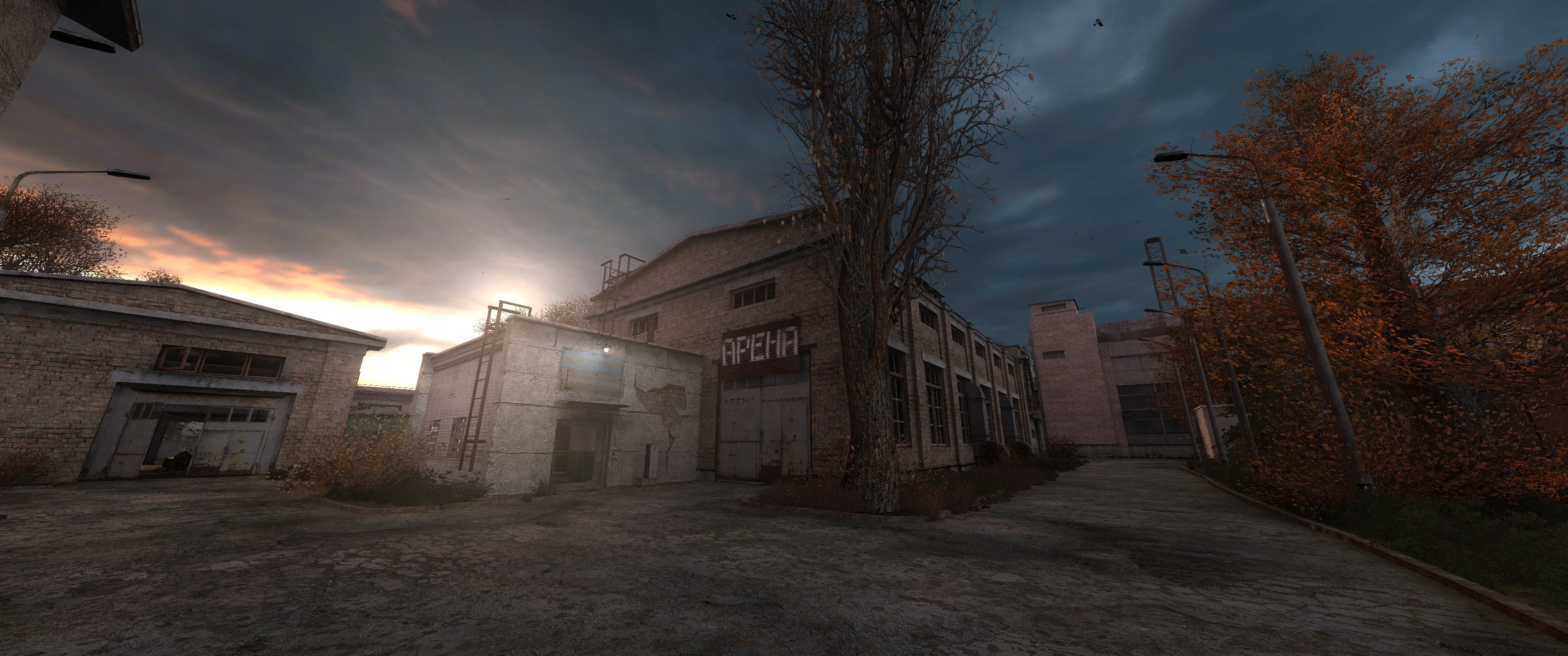
NLC 7 uses a modified version of Shadow of Chernobyl’s X-Ray engine called Zagolski hybrid engine. It is DX9 only; DX8 is effectively broken (although there’s apparently a patch for this) and DX10/DX11 weren’t added, though a separate perpetual-beta DX11 upgrade exists (not recommended at all, unstable). Despite being DX9, every new rendering feature from Clear Sky and Call of Pripyat was added, except for the few that need DX11 such as tessellation which was barely used anyway, and also with the exception of MSAA. So that means ambient occlusion (both HDAO and HBAO), improved parallax mapping, soft water, pseudo dynamic wet surfaces. Texture work is also substantially improved but there’s no real anti-aliasing. Supersampling can be forced via NVIDIA drivers if needed.
The resulting technical graphics fidelity generally surpasses that of Call of Pripyat and is on par with Clear Sky. Of course a new weather overhaul is in place, and it looks both unique for the series and more lifelike as well. It is mostly very good except for some low resolution skyboxes like the one shown below.
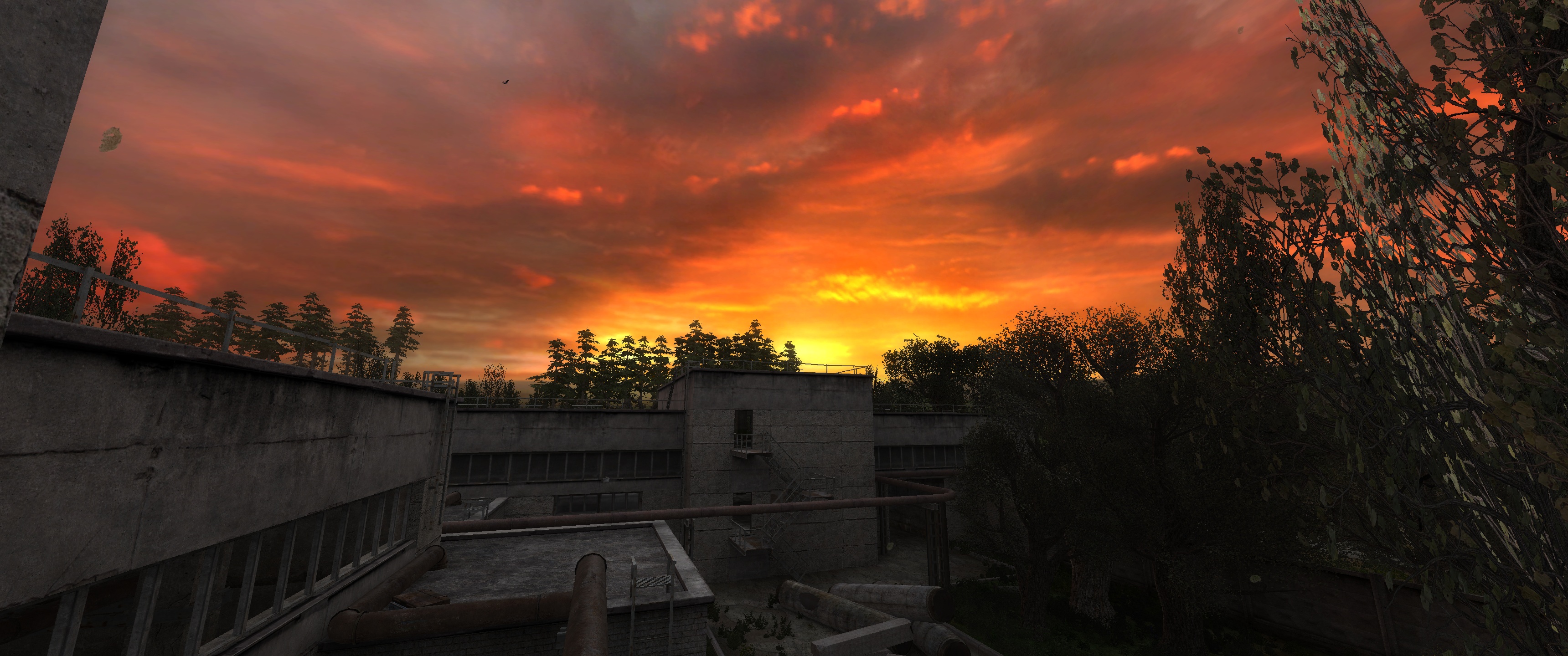
This is obviously not your ugly, overused, unimaginative Misery mod look with everything being grey and dead. No, vegetation is reclaiming the terrain, so like most modern mods there’s potential for far more grass density but this can eat up performance.
Speaking of performance, NLC 7 is generally light, not far beyond Shadow of Chernobyl performance requirements but it does have some areas with significantly more CPU bottlenecking which will cause frame rate to drop to the 40s on any PC. This is most notable in Darkscape since it’s a large area with lots of grass and lots of AI, though turning grass density down helps a lot.
Stability would be great if not for the fact that it’s 32-bit and prone to out of memory errors at modern resolution (even 1080p). I had to play the Chernobyl Power Plant levels at 800 x 600 in order to remain stable. This really needs to be addressed ASAP, but it never will be.
One of the cool things about Zagolski hybrid engine, and unlike every other version of X-Ray is that it actually has proper error handling and thorough logging. It doesn’t crash at a missing mesh like GSC’s engine, it can keep going, and the same applies for most kinds of errors. Things we take for granted that X-Ray never had in the first place due to its poor code quality.
Here is a technical overview of NLC 7, which I remind you is a standalone install:
| 64-bit | No |
|---|---|
| Native Linux Support | No |
| DRM Free Version Available | Yes (GOG and Steam) |
| Graphics API | DirectX 9 |
| RTX Remix Compatible | Unlikely due to instability and broken DX8 renderer |
| Frame Rate | Unlocked |
| High Resolution Support | Yes |
| Ultrawide Support | Slightly Flawed (with HD UI mod) |
| High Refresh Rate Support | Yes |
| Borderless Windowed Support | Requires third party software (SRWE or Special K recommended) |
| VR | No |
| Display HDR | No (force with Special K) |
| Frame Times / Stutter | Severe in certain levels at certain points in the game only |
| Ray Tracing | No |
| Mesh Shader Virtual Geometry Pipeline | No |
| Micro-Meshes | No |
| Advanced Distance-Based Level Streaming System with No Loading Screens | No |
| Loading Times | Agonizing |
| Variable Rate Shading | No |
| Sampler Feedback Tiled Texture Streaming | No |
| Sampler Feedback Texture-Space Shading | No |
| DirectStorage/RTXIO | No |
| Multicore CPU Support | 1-2 cores |
| GPU Physics | No |
| Adjustable FOV | Hex Edit |
| Anisotropic Filtering | 16x |
| Anti-Aliasing and Upscaling | None (NVIDIA users should force SGSSAA, everyone else force SMAA) |
| DLSS/FSR/XeSS Used for Dynamic Resolution? | N/A |
| Sound API | OpenAL |
| Sound | Up to 7 channels |
| Dolby Atmos | No |
| UI Scaling | No (HD UI mod is good for 4k and below) |
| “Analog” Keyboard Support | No |
| Compressed Game Files | Yes |
| Approximate Game Install Size | 14 GB (with graphics mods) |
| Debug Console | Limited |
| Modding | Yes (closed source mod) |
Note while there doesn’t appear to be any UI scaling, it’s not too small at 3840 x 2160. I’d be really concerned at 5k and 8k. We do highly recommend the HD UI mod nevertheless, especially if playing above 1080p but it looks better at any resolution.
Speaking of UI, NLC 7 is the only thing in the franchise that keeps the original aesthetic but updates it to not look so horribly out of date. Clear Sky is full of huge, low resolution blurry icons and borders everywhere, also shared by the minimap in all 3 games. NLC 7 has none of that; we mentioned the minimalist HUD earlier which is only temporary, but all the UI borders are refined, the textures are much higher resolution even without the HD UI mod, it is the only thing in the franchise that keeps the original somewhat utilitarian aesthetic while being presentable to this day.
A few other mods are presentable to this day at least at 2560 x 1440 and below, but with totally different aesthetics which isn’t a bad thing (see SFZ Project). Also, NLC 7’s HD UI mod is the only S.T.A.L.K.E.R. UI I’ve seen that is suitable for 4k resolution as well as ultrawide displays. Everything else including the original UI is too lacking in resolution.
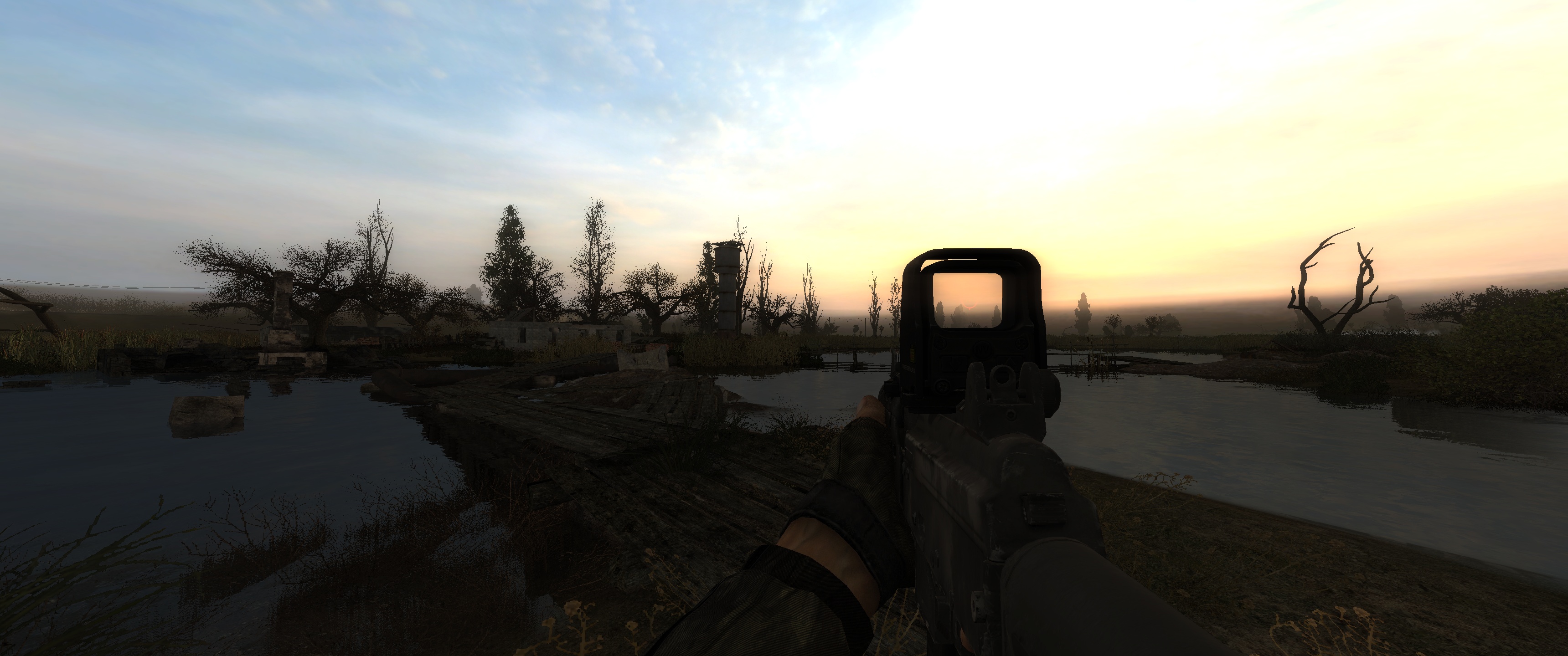
The only soundtrack is ambient music. Tracks from both Shadow of Chernobyl and Clear Sky appear in NLC 7, along with some outstanding new ones for which I don’t know the source. It is perfect and thankfully there’s not even the option for Clear Sky’s awful dynamic music. Still, I can’t help but wonder how Mick Gordon or Pathologic 2’s composers (Vasily Kashnikov, Nick Balinov, Theodor Bastard, Charly Newar) would score this game.
NLC 7’s ambient sound design is also better than the original games and better than most mods in this regard too. They set the mood for this game differently on each map, although you can still tell which sounds are fake ambient sounds and which are real. Some of the new mutant sounds, like the Bloodsucker’s new ability or the new Burers, are excellent, big improvements over anything else in the series.
Gunshots are certainly improved over the base game, although better sound does exist in some other mods and NLC 7 doesn’t complete the unfinished EAX implementation from the base game. NLC Hard Edition 2.3 includes improved surround spatialization that’s very nice, do not use OpenAL Soft with it!
Conclusion
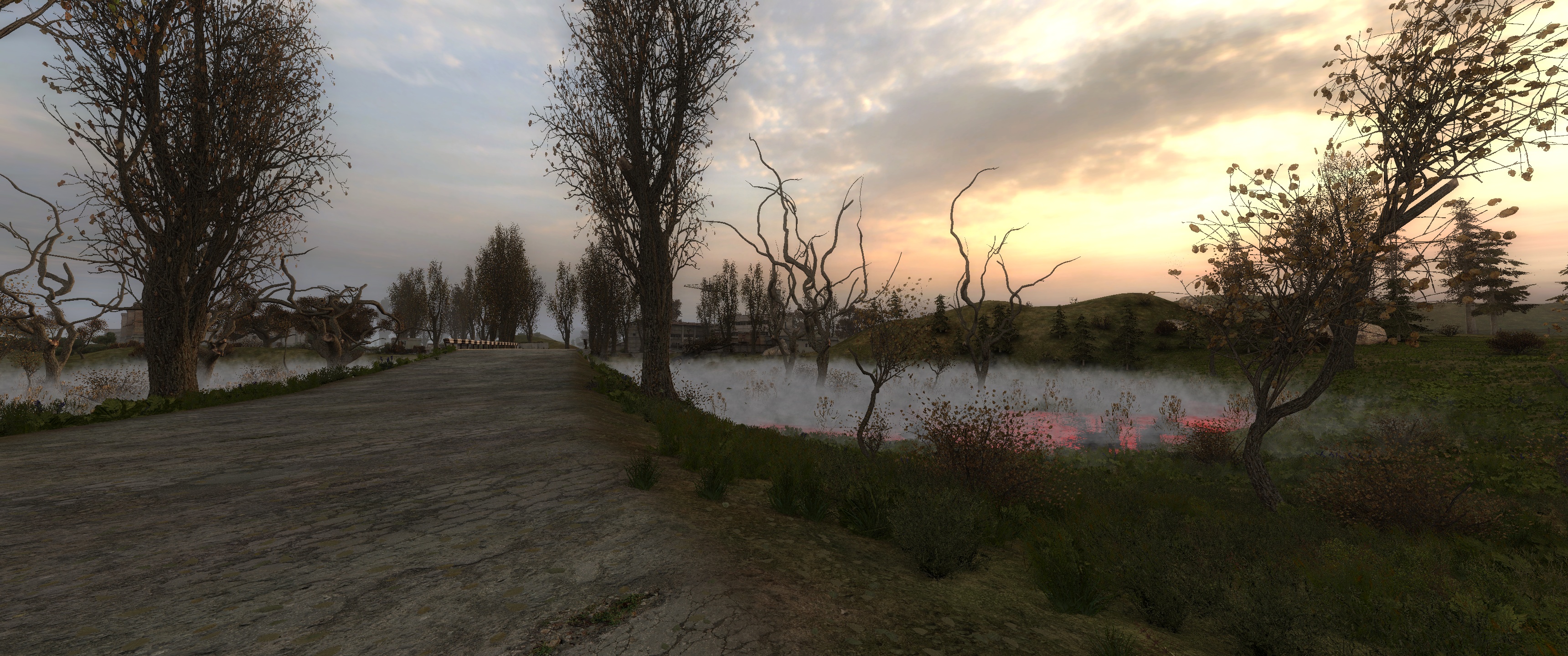
All three S.T.A.L.K.E.R. games and every other mod, even the best ones like OGSR and Oblivion Lost Remake/Vector of Alienation, all of them miss more potential than they realize. That isn’t to say that they’re bad, it’s just that S.T.A.L.K.E.R. has so much potential for writing/narrative design and gameplay depth but they don’t quite reach them.
NLC 7 is the only S.T.A.L.K.E.R. I’ve played (and I’ve been playing since 2008) that actually tips that scale. It reaches most of its potential unlike everything else I’ve played in this series, official and unofficial. It is a modification many years in the works, and it’s on a much higher level than any of the three official S.T.A.L.K.E.R. games and any other mod. It’s like comparing BioShock to System Shock 2, the Deus Ex prequels to Deus Ex itself, Thief 2014 to Thief Gold or Thief II: The Metal Age, Unreal Tournament 3 to Unreal Tournament 2004, Torment: Tides of Numenera to Planescape: Torment, The Outer Worlds to Fallout: New Vegas, Tyranny to Star Wars: Knights of the Old Republic II – The Sith Lords. NLC 7 is like the latter game in all of those analogies: infinitely more rich, substantial, intelligent, and replayable.
Aside from out of memory crashes caused by it being 32-bit (a major issue), and aside from a few obviously borrowed character models, it doesn’t look or feel like a mod since the consistency is so great and the attention to detail is rivaled only by the very best of games.
Its writing quality is on a level that very few games even attempt to reach. Its quest design is more like that of Pathologic 2 and the classic Fallouts (the first two) than a typical nonlinear FPS. It has greatly improved survival mechanics that are logical and not obnoxious yet make for one of the more hardcore survival FPS experiences in gaming, improved character progression, much improved shooting mechanics and animations, a nearly perfect UI. NLC 7 seeks to perfect every aspect of S.T.A.L.K.E.R.’s design within a huge but very clearly defined scope, and it largely succeeds within the limitations of its engine. This is a very rare achievement in gaming.
Something with this much depth, intelligence, attention to detail, and quality just has no place in modern day gaming. This is why I’m calling it the masterpiece that nobody (in the west) knows about. But of course, the lack of a proper translation is a major reason for that but even if it had one, it’d be doomed to the same fate as Pathologic 2 because it’s not casual enough. Most gamers don’t want to have to think in order to figure out how to advance in a game, except for those playing puzzle games but that’s a separate audience. The masses, including just about everyone who will be buying S.T.A.L.K.E.R. 2, just want to be spoonfed easy, entertaining content rather than having to work for it. NLC 7 makes you work for it.
This is why I’m not looking forward to S.T.A.L.K.E.R. 2. It is a mainstream game carrying the XBOX logo. There is no scenario in any timeline or parallel universe where that has a positive outcome. No matter what, it will inevitably be a tiny fraction of what NLC 7 is, because NLC 7 doesn’t cater to Fortnite and Call of Duty: Warzone players. The only thing about S.T.A.L.K.E.R. 2 I have a shred of hope for is the possibility of an NLC mod for it.
Strengths
- Immense writing quality. It is a massive 80-100+ hour experience yet the plot only gets more interesting as it progresses. Characters are written like actual people instead of just quest giving robots, world building is so much deeper than anything else in the series, it is so much more mysterious, it succeeds as an existential horror story, the pacing is absolutely perfect.
- Quest design is top tier and really nonlinear, with more ways to handle them than most RPGs and more consequences that aren’t all immediate or obvious too. Nothing like the original games or any other mod in this regard, far superior to those and to your modern day watered down RPGs (including cRPGs) as well.
- While it mostly uses original game maps plus a fair amount of new ones, every level is full of interesting content except for the one that is forever an exception, Darkscape.
- Much more creative, challenging, and ominous labs
- The economy revamp is brilliant. Not relying purely on one form of currency is what this game needed all along. No more “sell some artifacts, get rich, buy the best stuff and conquer the entire game” here.
- Brilliant character progression despite the 80-100+ hour length. You’re never too stagnant, every step up is immensely rewarding due to the very thoughtful quest rewards and stashes, but you don’t become too overpowered to the point of breaking the game or feeling safe either.
- Very good survival FPS gameplay that also consistently presents a proper challenge from start to finish, has perfect character progression from start to finish, and the new mutant designs are a noteworthy step up
- Great selection of weapons; not overdone and not too few, no more straight weapon ladder progression – the absence of this results in more feasible character builds.
- Excellent recoil animations and some features that don’t appear in other mods or games like scope reticle illumination
- Artifact gameplay massively improves character progression and can be addicting but never annoying or too grindy. The newly designed artifact belt system and artifact container system are logical and functional improvements, pretty much perfect.
- Anomalies are more… anomalous than ever in NLC 7, and also more dangerous than ever plus they move after each emission. By far the best anomaly design in the series.
- Actually does a good job incorporating Clear Sky’s story into the lore, without the bad parts and plot holes of Clear Sky’s story
- Excellent UI, especially with the HD UI mod
- The engine improvements are nice, yet it lacks the most crucial one which is 64-bit
- Very nice, consistent visual design, a step up from the base games and most mods
- Free, standalone download
Weaknesses
- 32-bit so you will see out of memory crashes at some points in the game (Darkscape later in the game, possibly Radar and Ivankov District and Limansk and Tesla Zone, certainly CNPP-1 and CNPP-2)
- They removed the console/terminal, as if this is a perfectly polished experience that nobody would ever need to tinker with or troubleshoot or maybe just use demo_record for a video or something
- Kum Mikhalych seems to have some unfinished, broken side quests in Build 3.0. I think they’re finished in Build 3.7.5 but I have yet to confirm.
- Mutant encounters are not dynamic enough
- A hardcore healing system like the one in Escape from Tarkov would be very fitting here, though medical items should all be contained within the three medkits, not all scattered about like a looter shooter here.
- While the shooting mechanics are greatly improved, there’s room for a lot of improvement here and in armor simulation demonstrated by games such as the aforementioned Escape from Tarkov. The best possible S.T.A.L.K.E.R. on X-Ray engine would be 64-bit NLC 7 with GUNSLINGER mod integrated.
- Unimaginative effects of radiation poisoning. If this many games are going to take place in a radioactive environment, they need to start getting more creative, or better yet more authentic here.
- No anti-aliasing – nonissue at 3840 x 2160 but is a problem at 3440 x 1440 and below
- I do believe the default, healthy and well rested movement speed is a bit too slow overall for such a long game with this much size and backtracking, though it’s fine for badly wounded characters, but this is easy to edit and an addon exists for this
- Being limited to campfire saves is actually a bad idea due to instability caused by out of memory crashes. Would be a great optional feature otherwise, although also providing the option to save anywhere is always preferable since some peoples’ living conditions demand it. Nonissue since an addon adds save-anywhere ability.
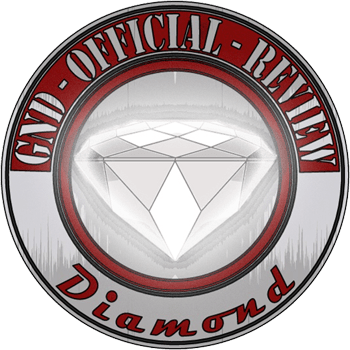

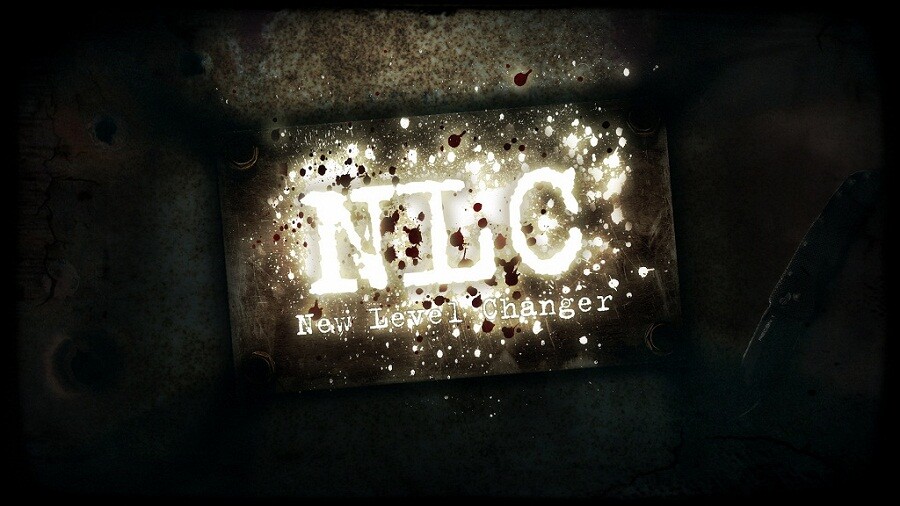

 (57 votes, average: 4.67 out of 5)
(57 votes, average: 4.67 out of 5)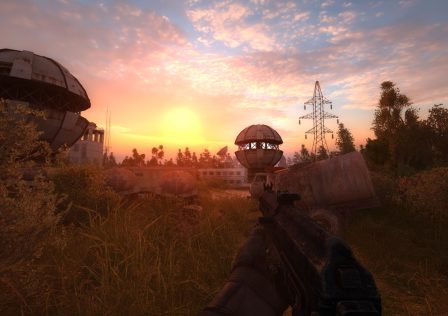
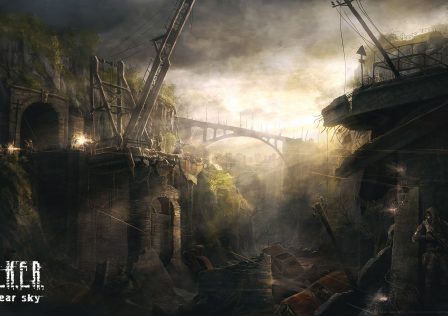

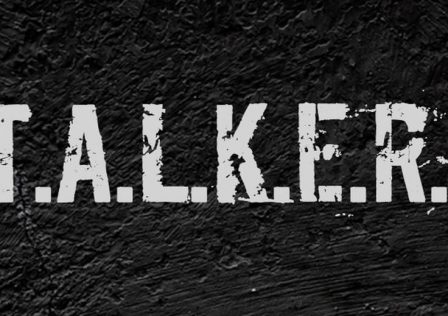
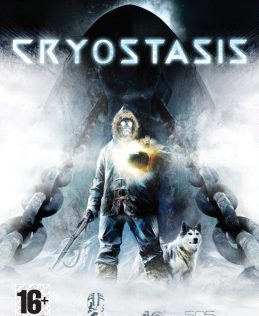
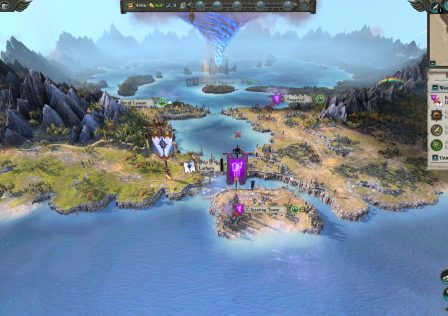

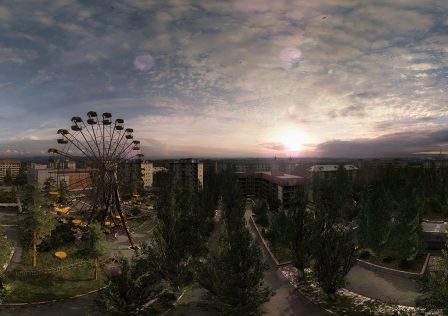

Seems like an interesting take on an ‘out there’ mod. While I give the mod author credit for bringing attention to an underrated mod, I sense a heavy bias when it comes to comparing this mod to vanilla games such as how they “Fail to deliver” when it comes to GSC’s take on Roadside Picnic’s unfriendly world, which is a complete fabricated lie, and reeks of favoritism. If GSC “failed to deliver”, there would be no Stalker 2, and this mod would not exist. A weird black sheep, this review, how intently detailed and yet still completely biased in terms… Read more »
“A weird black sheep, this review, how intently detailed and yet still completely biased in terms of actual fair critique, comparison and explanation.” Every argument I make is well supported. If you believe otherwise, provide examples. I stated that GSC’s games fail to deliver in, “…mysterious, inconsistent place that defies logic. Every step you take is supposed to worry you.” Let’s break this down. “Mysterious, inconsistent place that defies logic” – NLC 7 provides examples of world design following this principle, GSC’s games do not. Anomalies are entirely systematic and predictable throughout the entirety of all three games. They are… Read more »
I think cslantz comment is definitely in bad faith but I think your indisputably a bit browbeaty over this mod like an RPG codex goon would be and that’s going to get people pissed off. Additionally while your saying your not insulting the base STALKER trilogy or saying they are bad, the insinuations in not just the way you phrase things but the way the article is structured imply otherwise. Intentionally or not. Like yeah NLC 7 is closer to the film and book in terms of tone or presentation but I think STALKER as a game even at its… Read more »
GSC’s games are serious in tone – different than NLC 7’s tone, but nonetheless serious and without much humor. Of course Stalker 2 will be more like those, but my point is, I don’t see it adopting any of NLC 7’s brilliance. The hardcore survival nature of NLC 7 isn’t for everyone, but the quest design and interactivity simply stand out as far more ambitious and much greater achievements. So yeah, NLC 7 is obviously placed above GSC’s games in this review, as it sets out to accomplish a lot more and does so. It makes better use of its… Read more »
You know what I mean by pulpy. Pulpy doesn’t mean you don’t take yourself seriously or whatever. You can have a very serious tone that is still pulpy. Fallout for example can get very grim and serious but its pulp influence is very much there. Pulp does not mean “humor”. I’m specifically making a distinction between the literary sort of seriousness in Roadside Picnic vs something more action adventure focused like STALKER the game. And my point is yeah it wont adopt NLC 7’s way of doing things because right from the outset the vision at heart is very different… Read more »
I do think S.T.A.L.K.E.R. 2 and all large scale, nonlinear games would benefit in adopting a less linear, more open ended quest design like NLC 7 (even without the no-objective marker design). It just takes advantage of the space more, not sending you just from point A to B but giving you many options and having you figure things out on your own. It’d also benefit in adopting some elements of its currency system to improve progression and reduce exploitability, along with its more varied artifact balancing (and a similar amount of artifact tiers if it’s to be a comparably… Read more »
english version is unplayable. i have more hours in Stalker than anyone playing all different mods and i couldn’t make heads or tails out of the translations. i got to garbage by Rostok base and gave up. if just want to wander around and play a hard version then ok sure it’s hard and can do that but if want to actually finish the game and get through the storyline, you’re gonna need a miracle. smh.
Ditch Build 3.0 and switch to Hard Edition 2.3 (links are updated). This one has a comprehensible translation.
nlc 7 is the best stalker mod ever
Thanks for a fascinating read.
I sincerely hope this mod someday will have a proper translation, I just can’t get myself to play it with broken machine translations.
Gave the mod spin based off this review. Struggled through the first three quests, taking on mutants with nothing but a knife is a fool’s errand, but I think the mod is simply doing a good job teaching you that stealth and evasion are far more valuable tools here than in GSC’s entries. I’m through Wolf’s first errand and finally feeling like I’m beginning to understand how the game wants me to approach it. Cool stuff!
Absolutely stunning review of a mod that maybe, one day, will have its deserved recognition. This mod doesn’t even feel like a mod, it feels like a different take on the franchise, a way smarter take I’d say. Everything is more grounded and make more sense. I’d suggest to chug the bad translation anyway. It is that great.